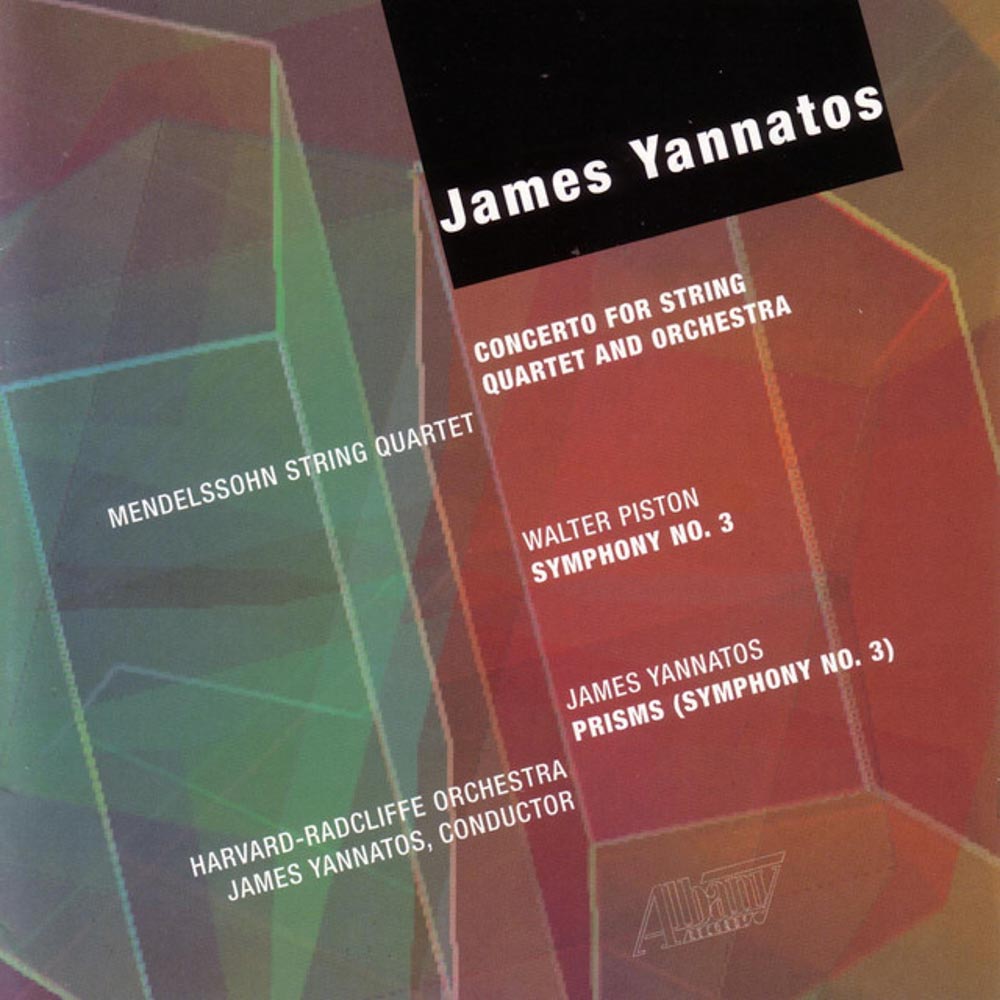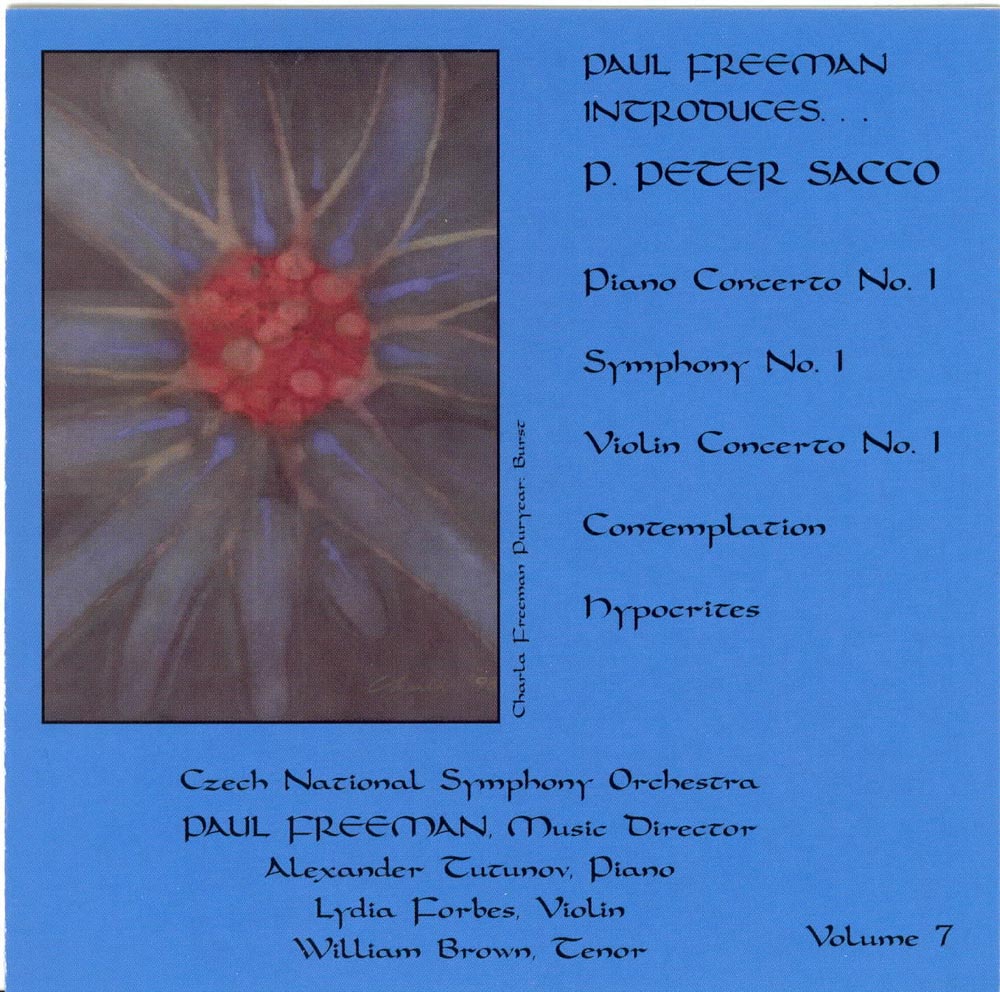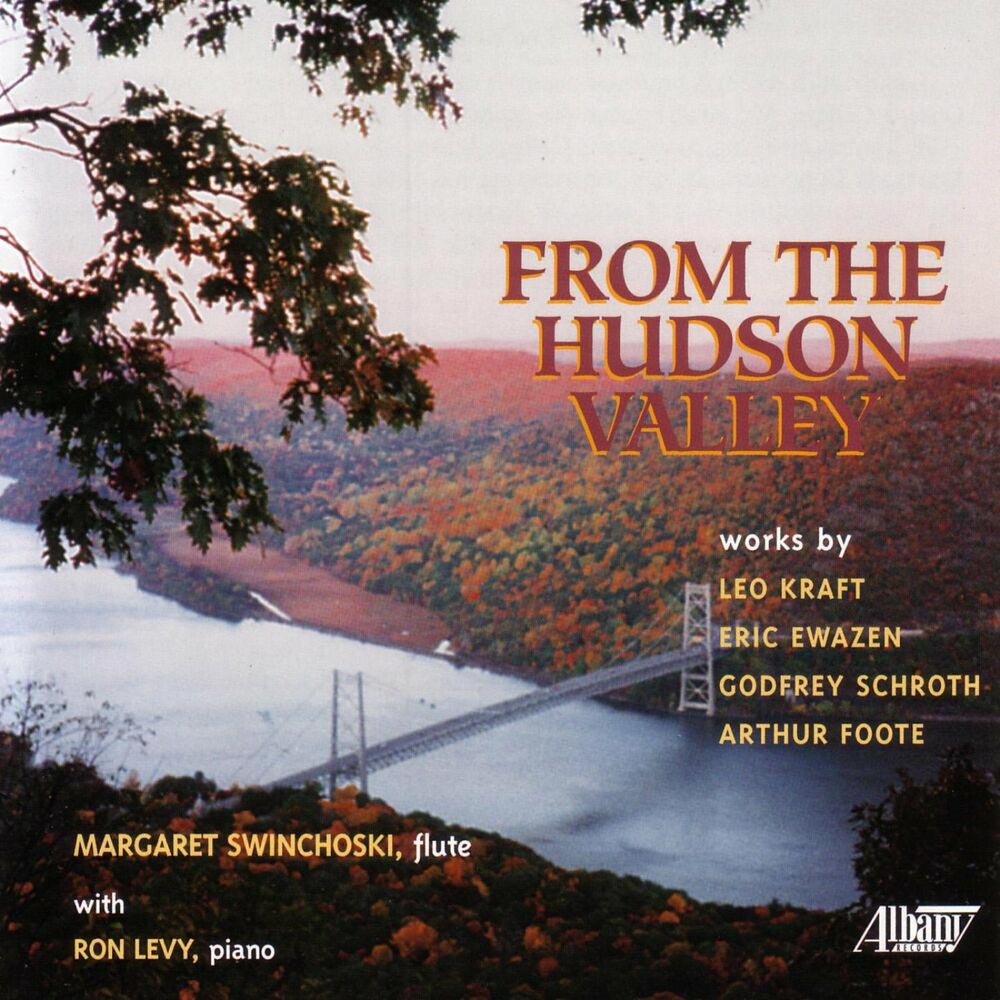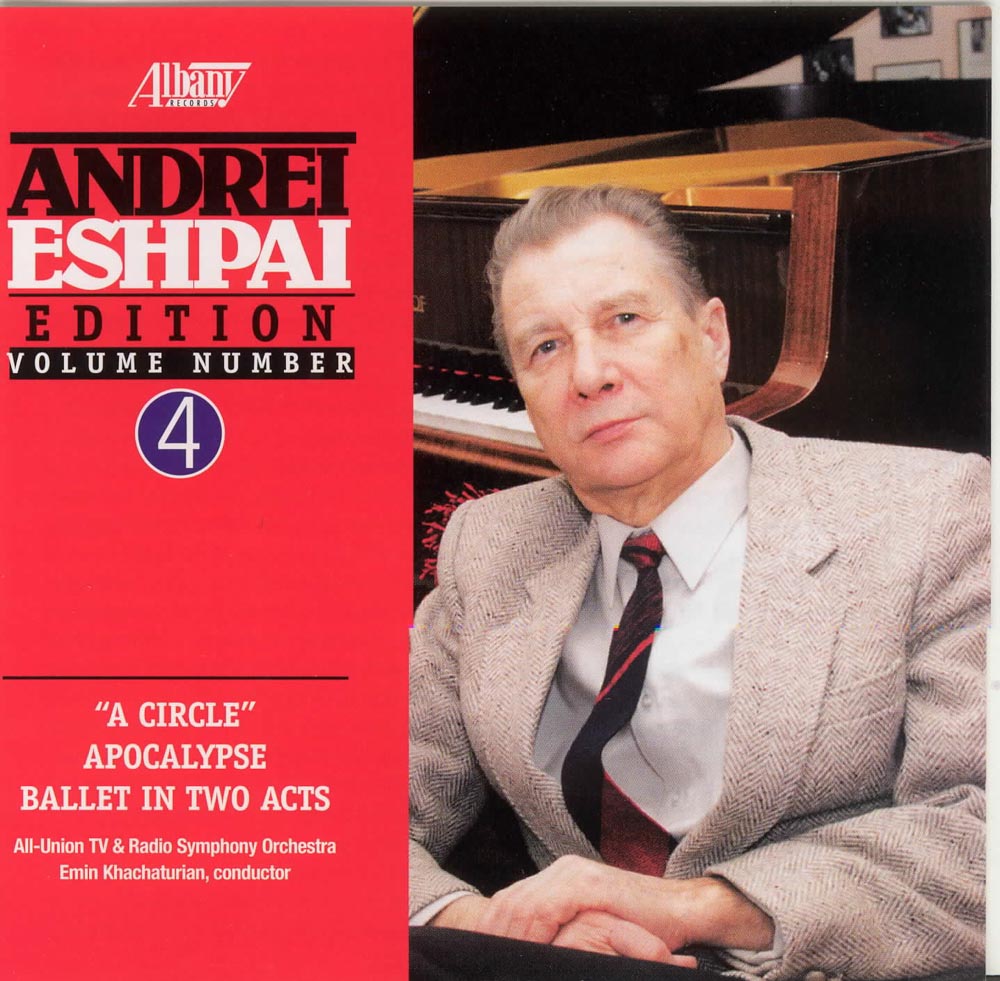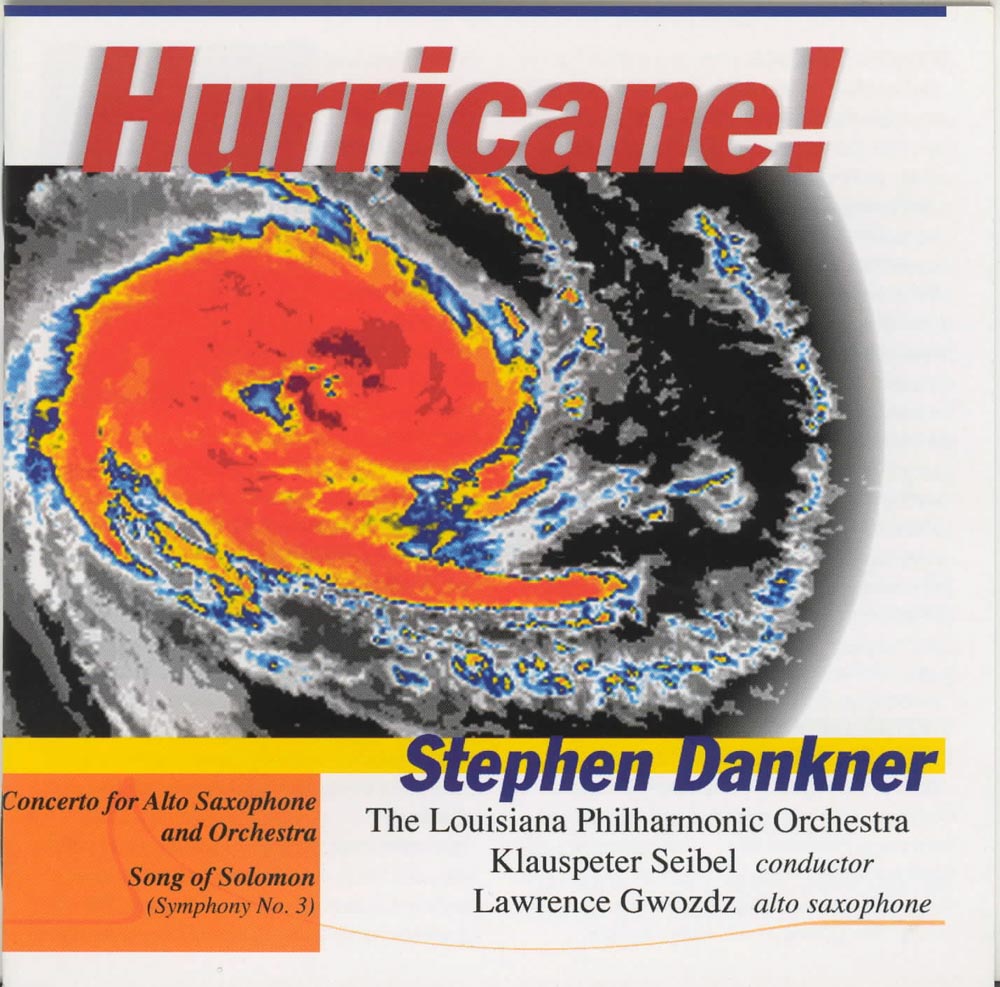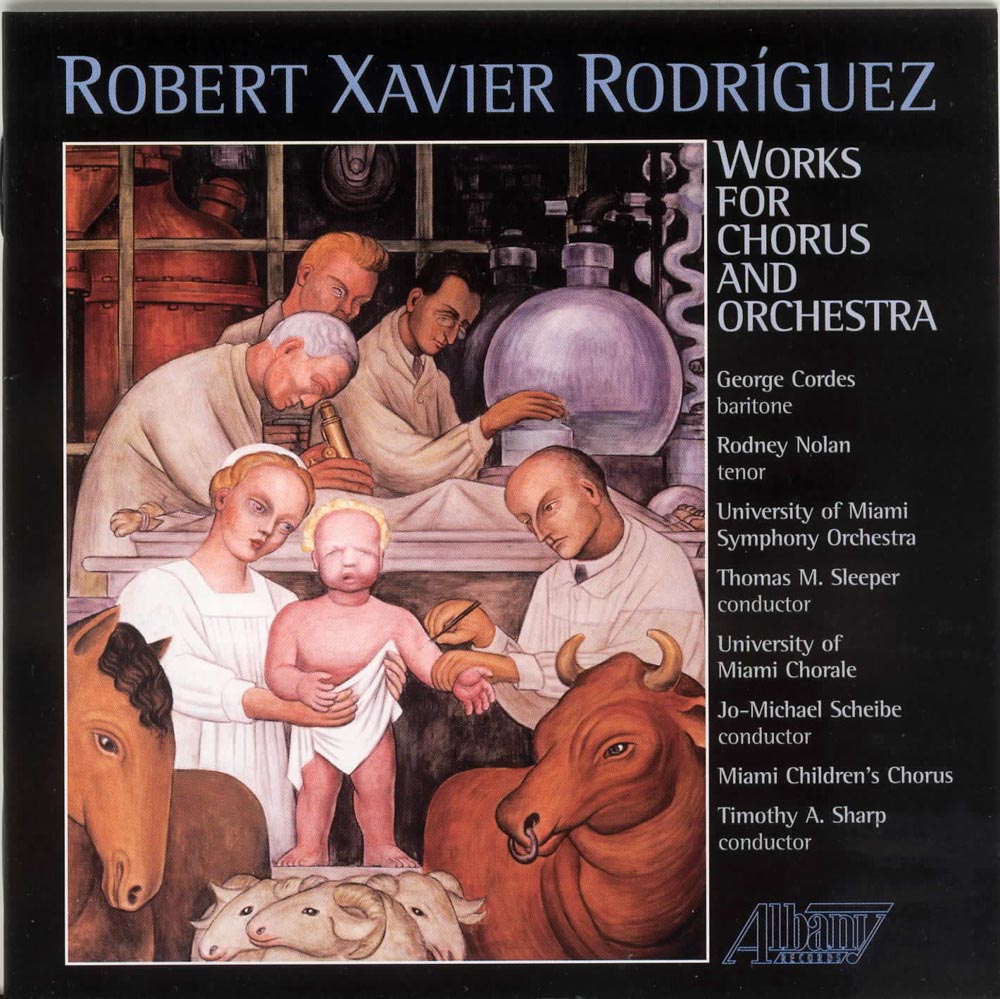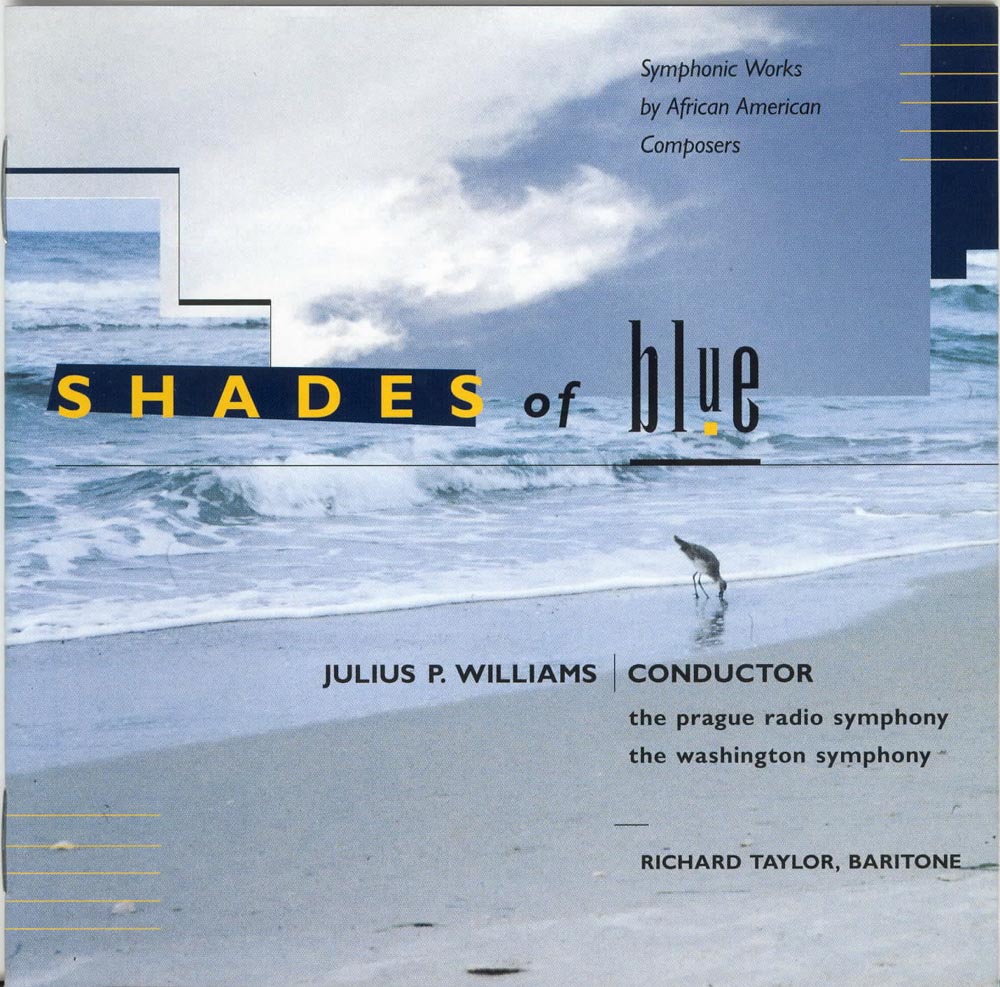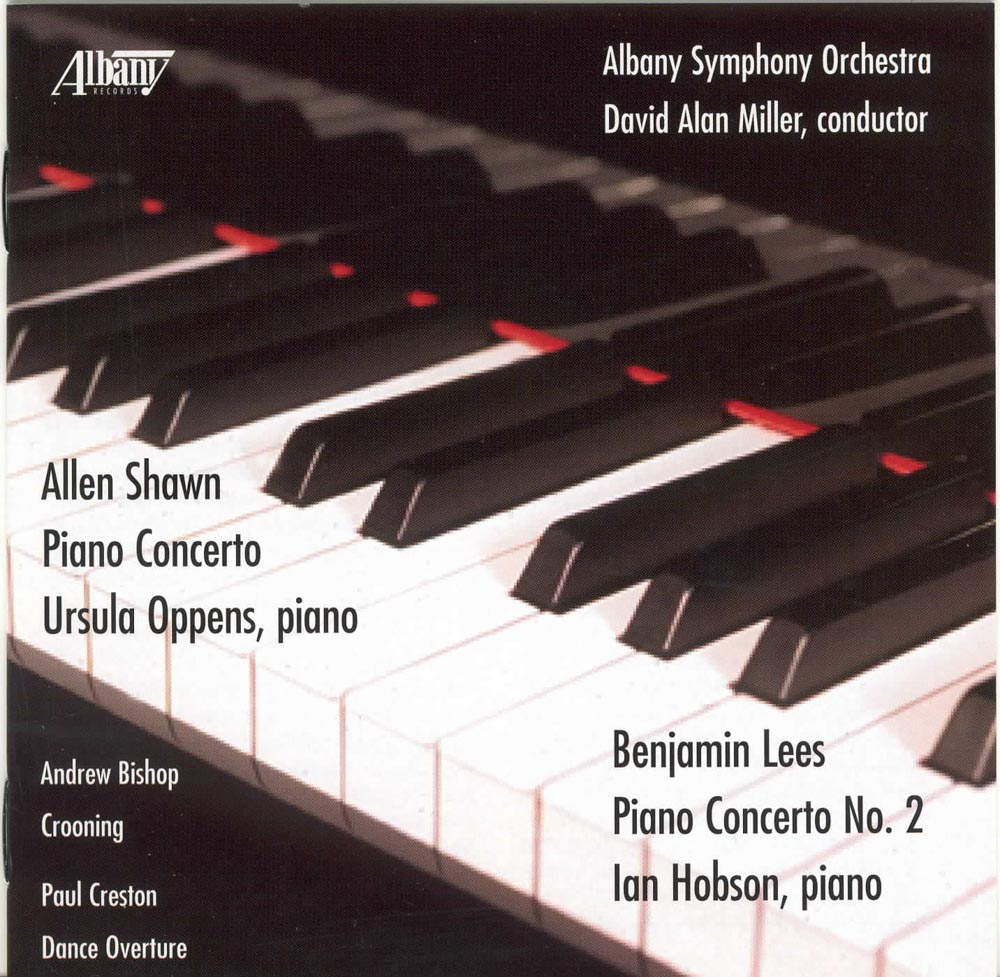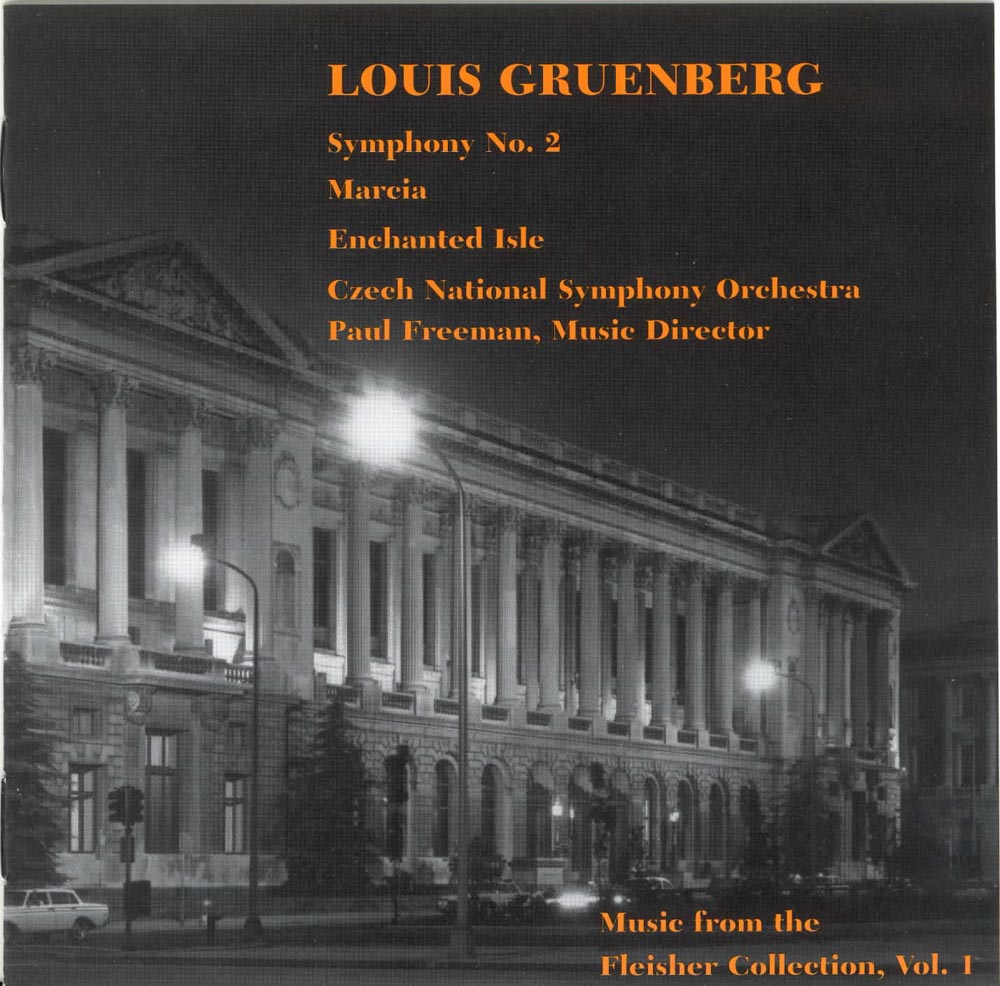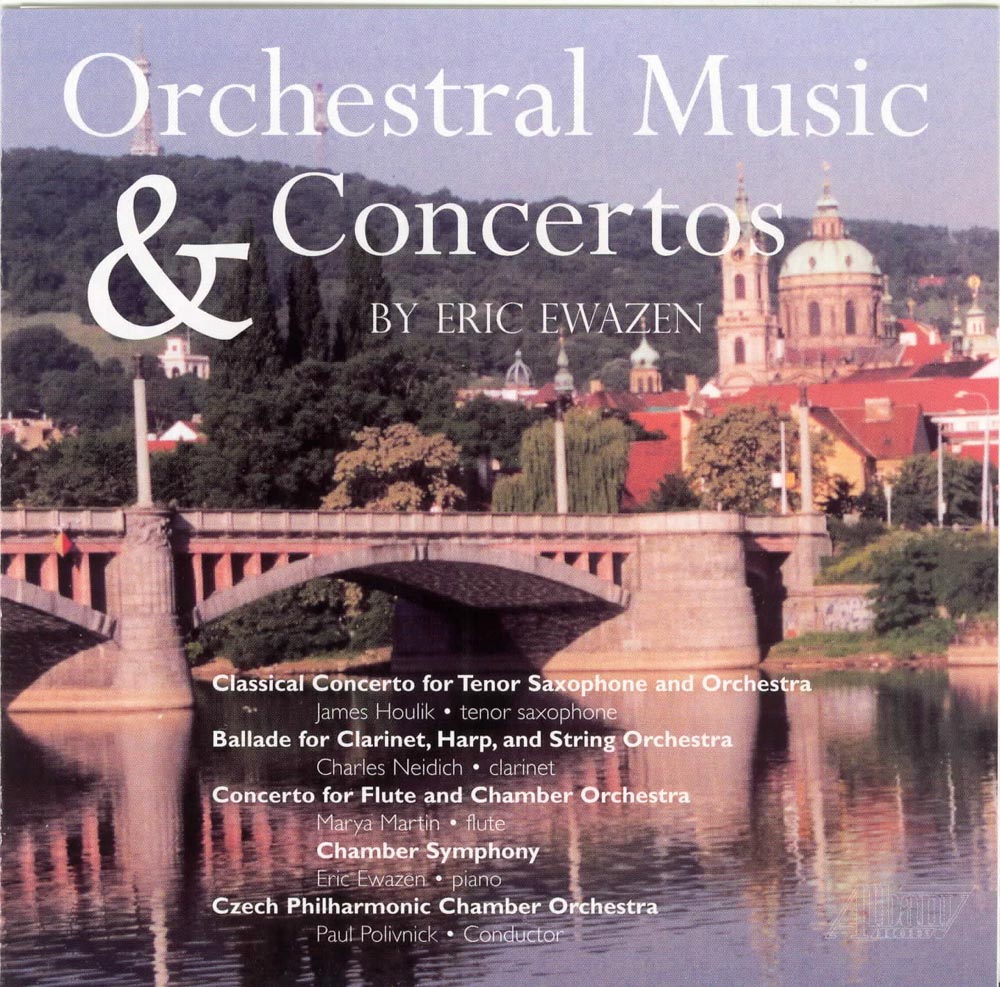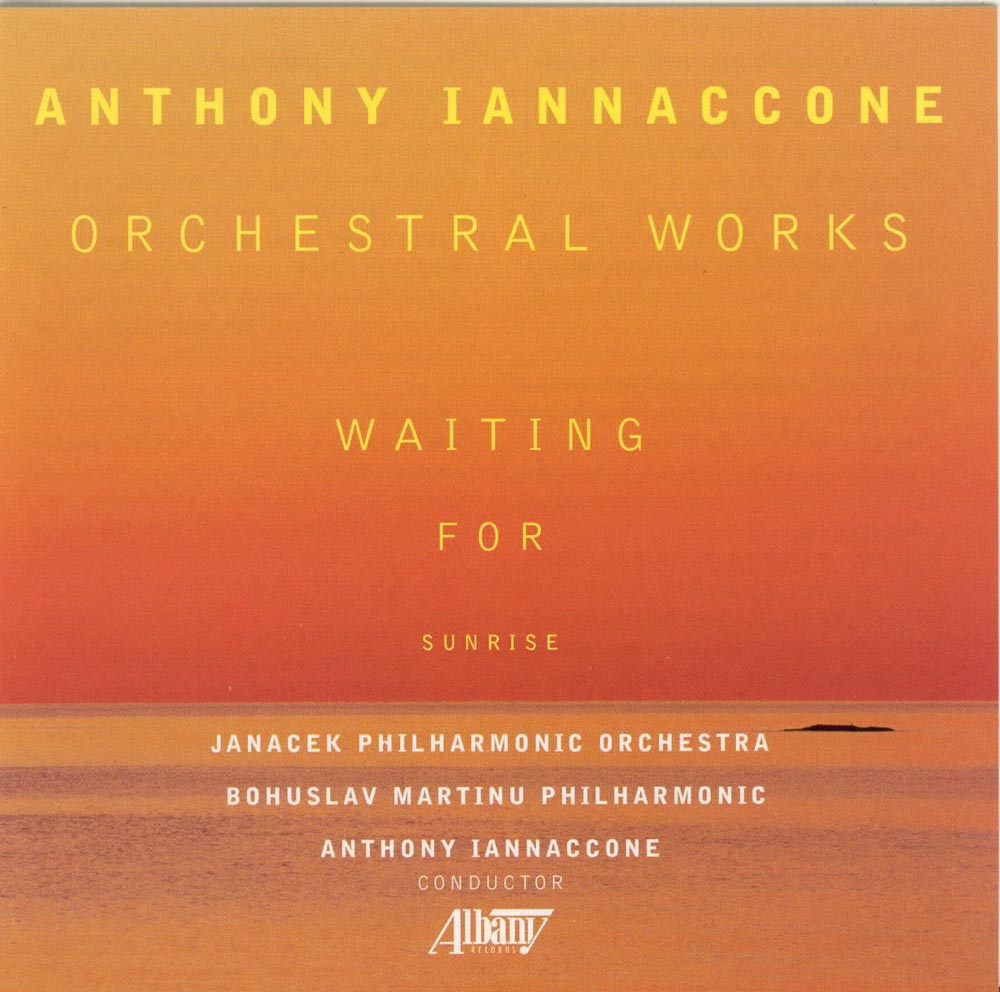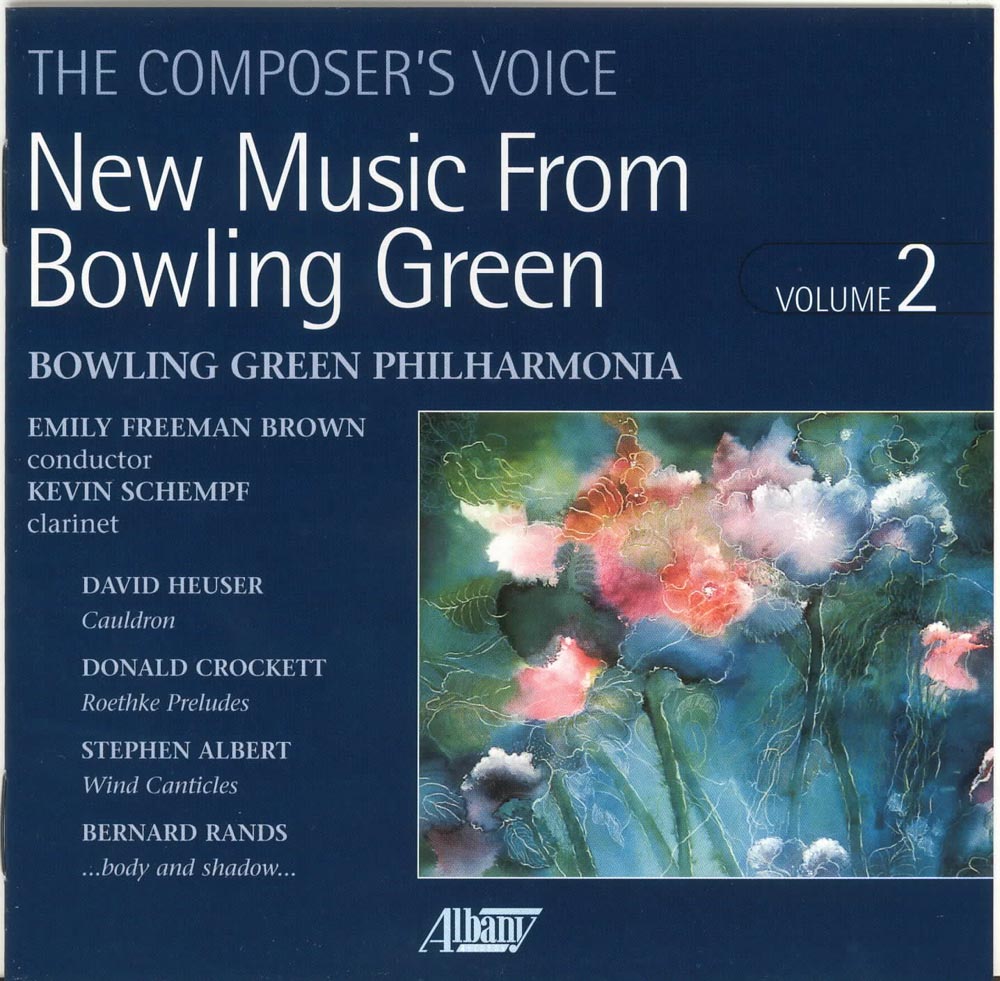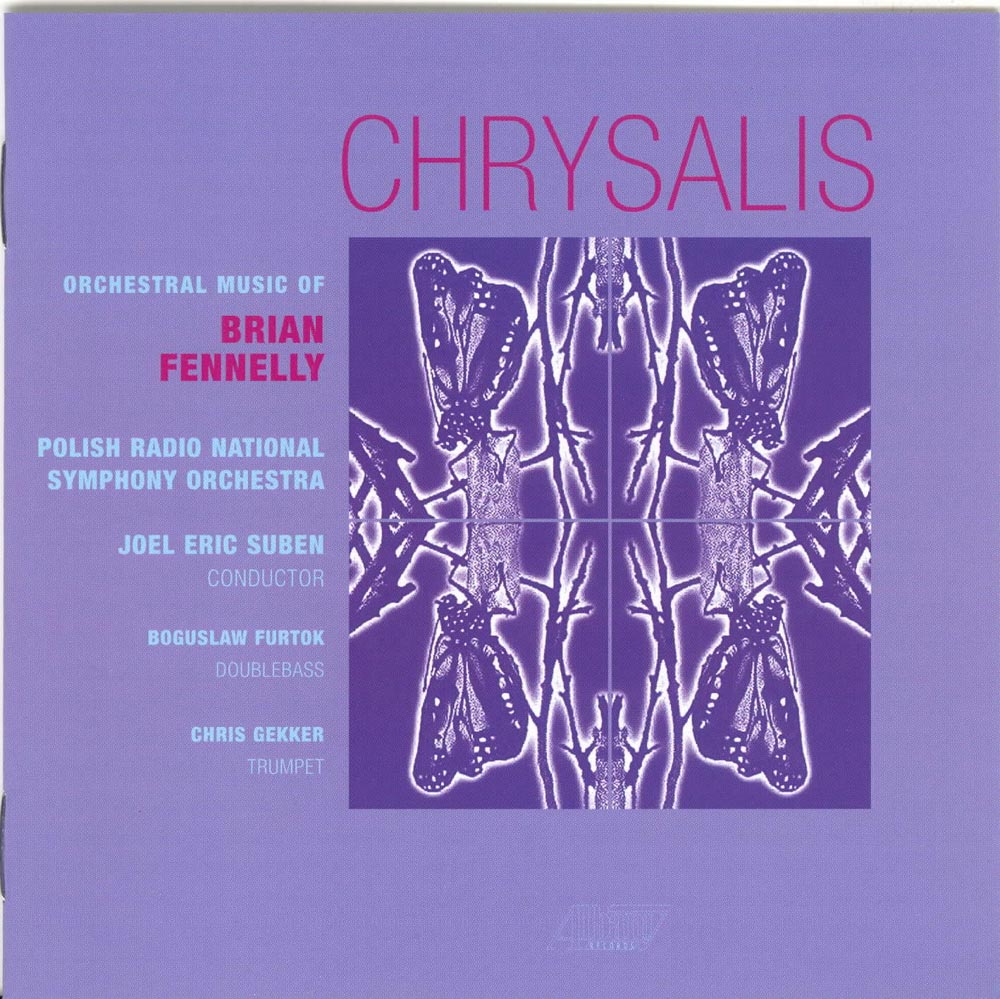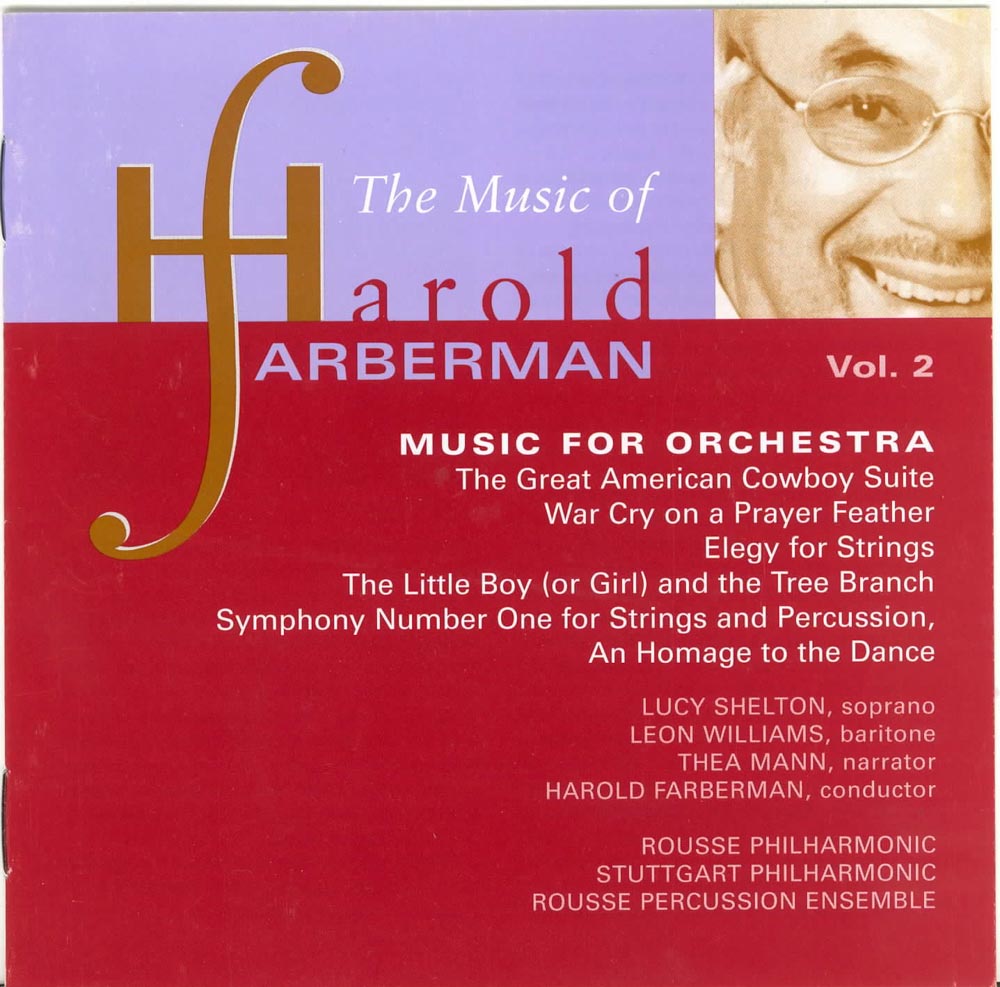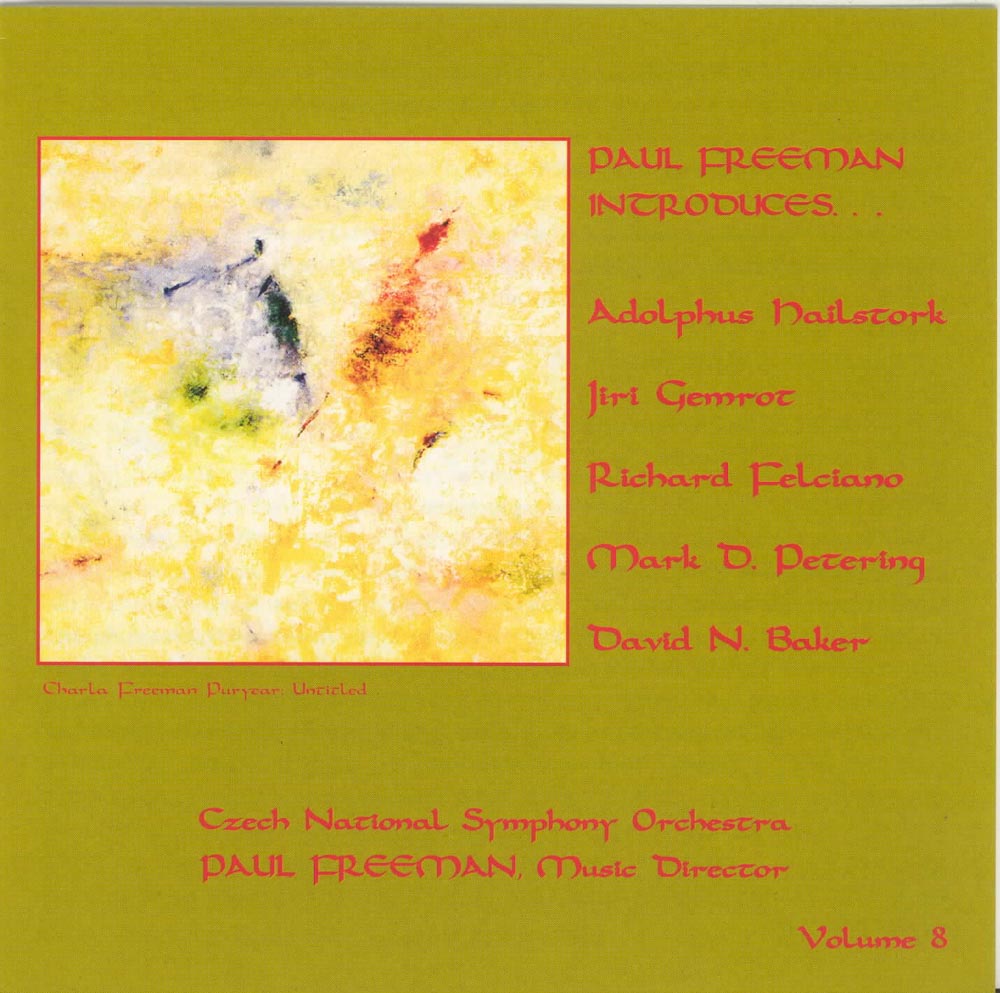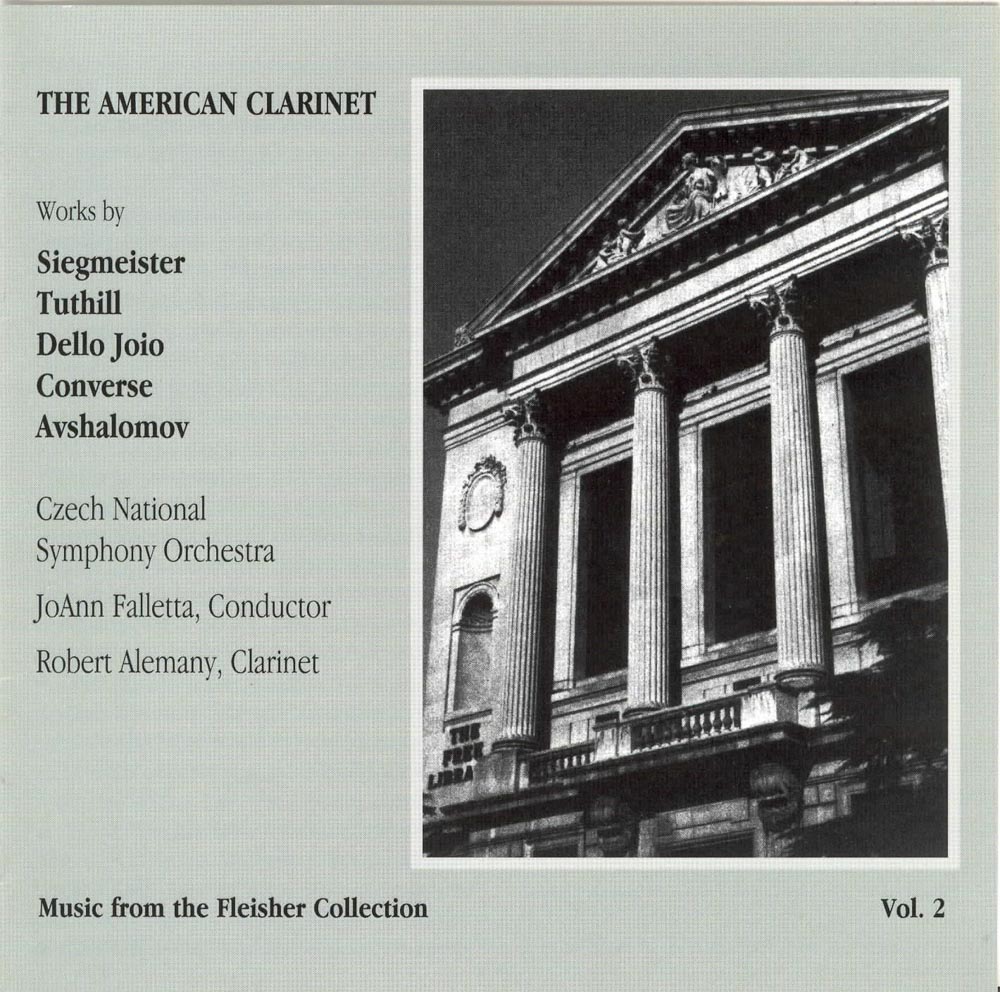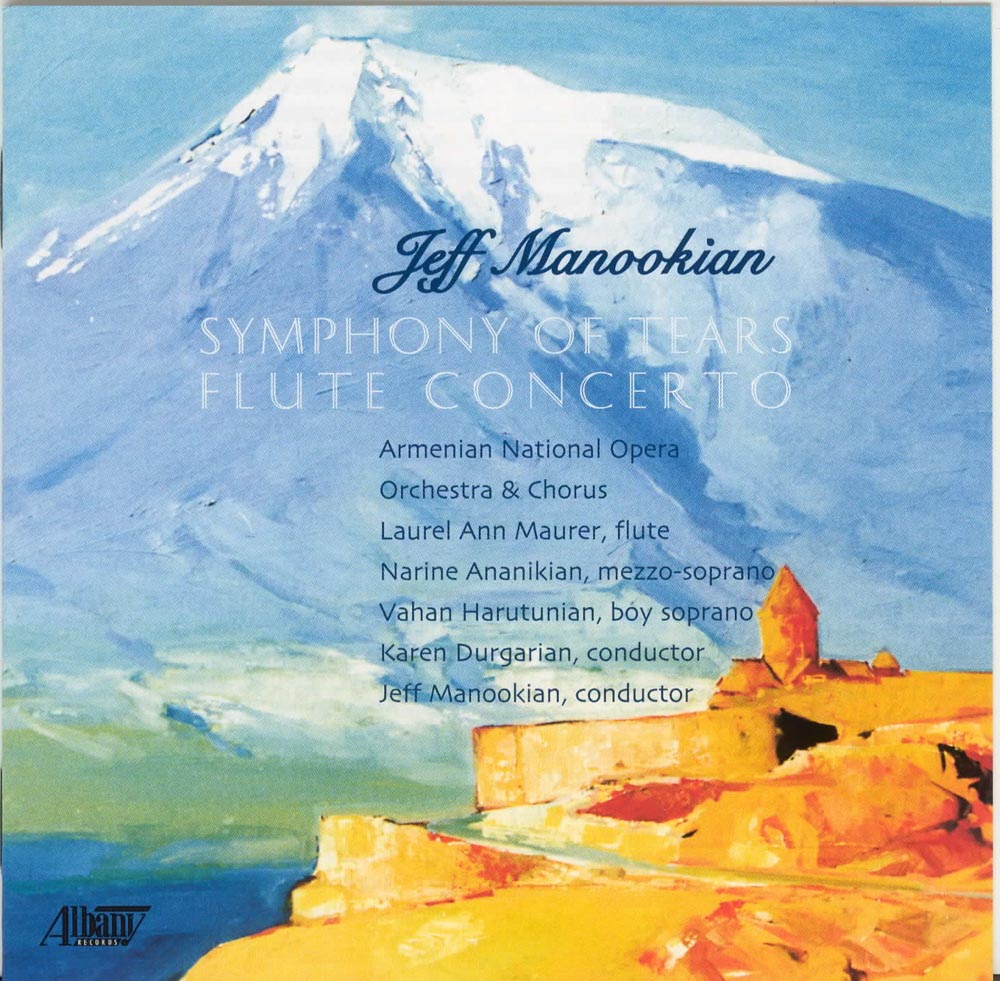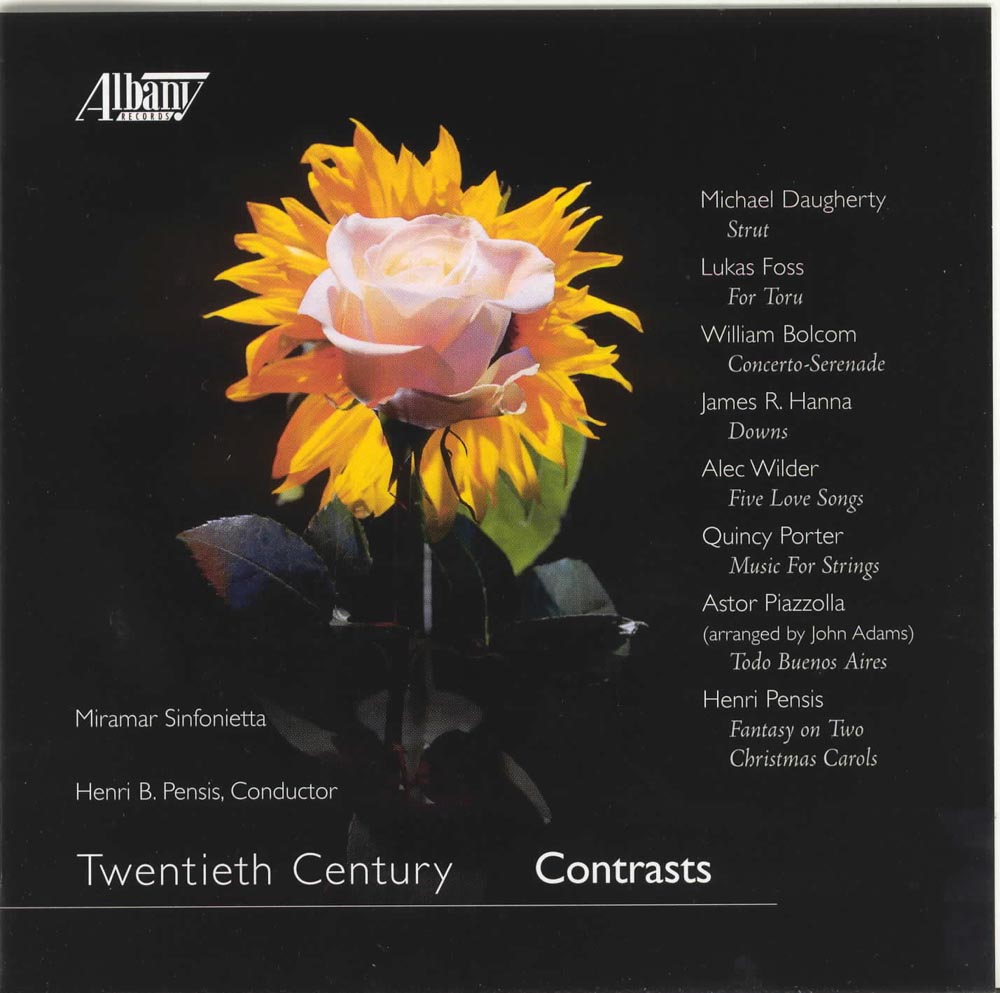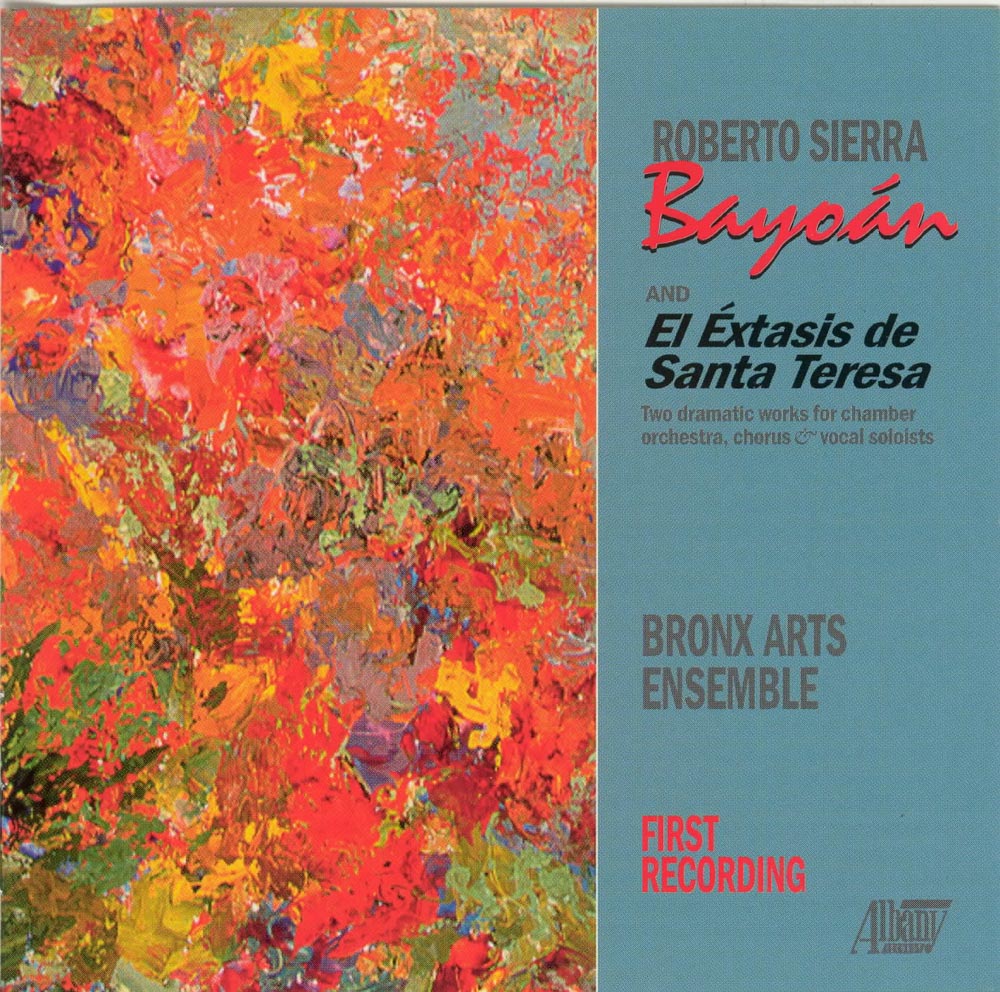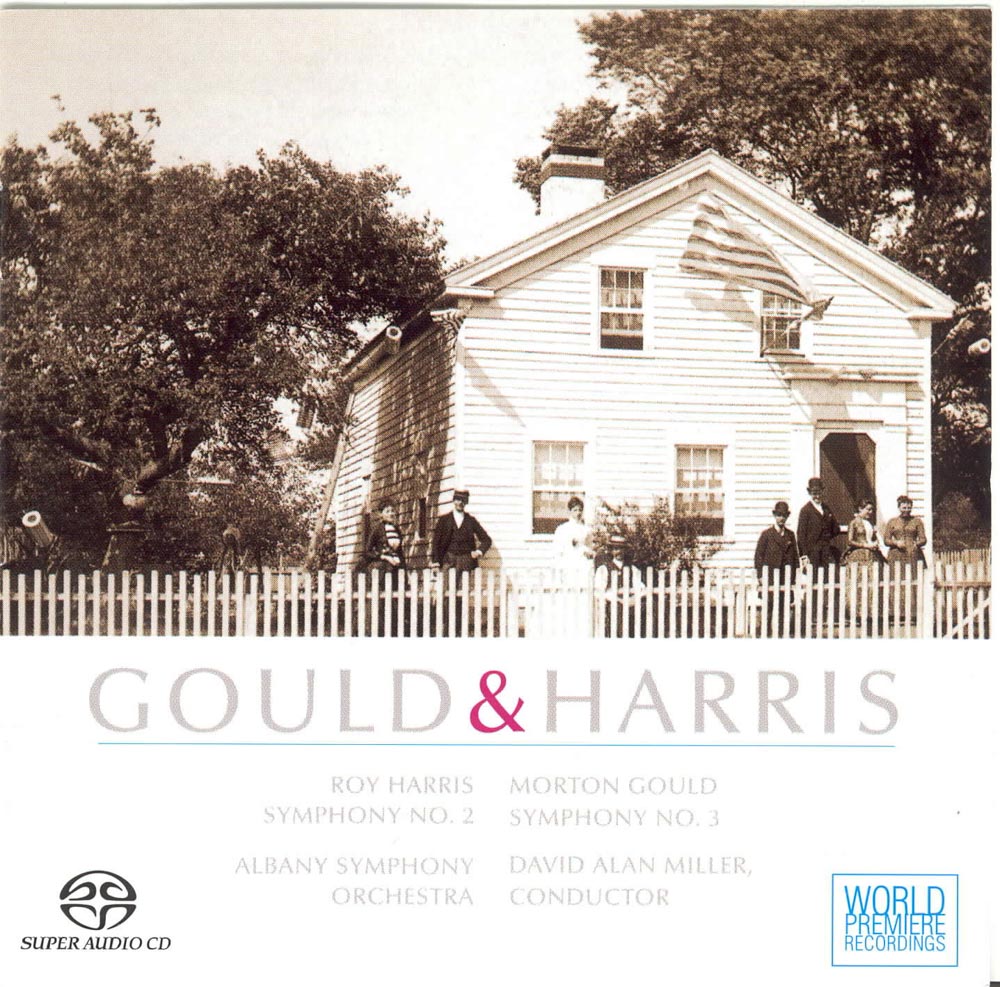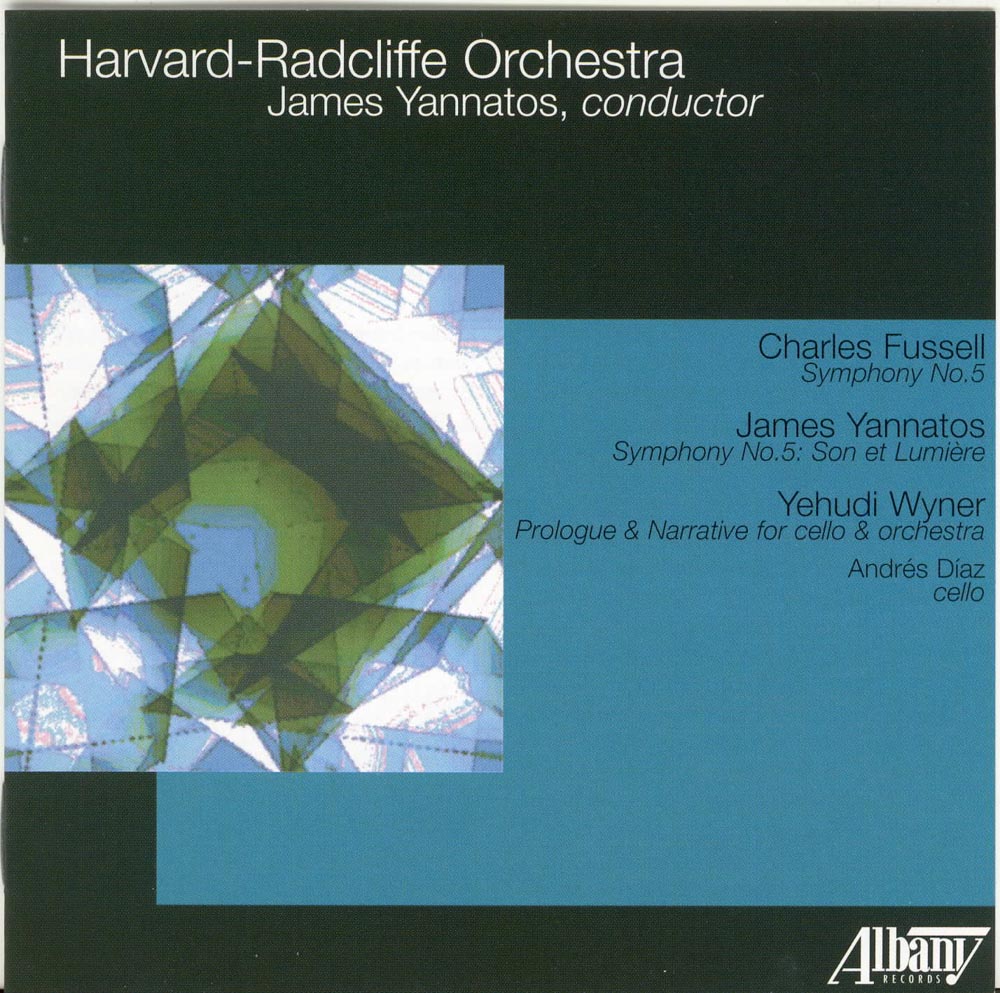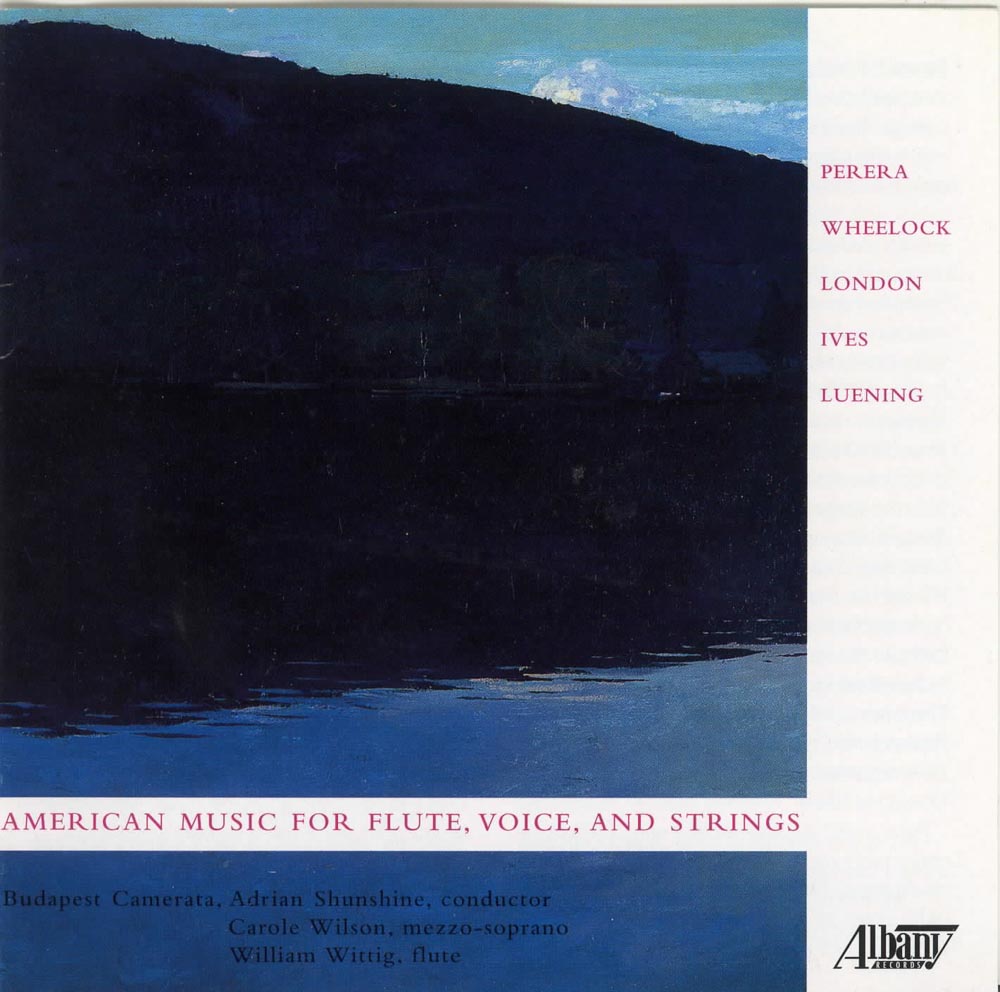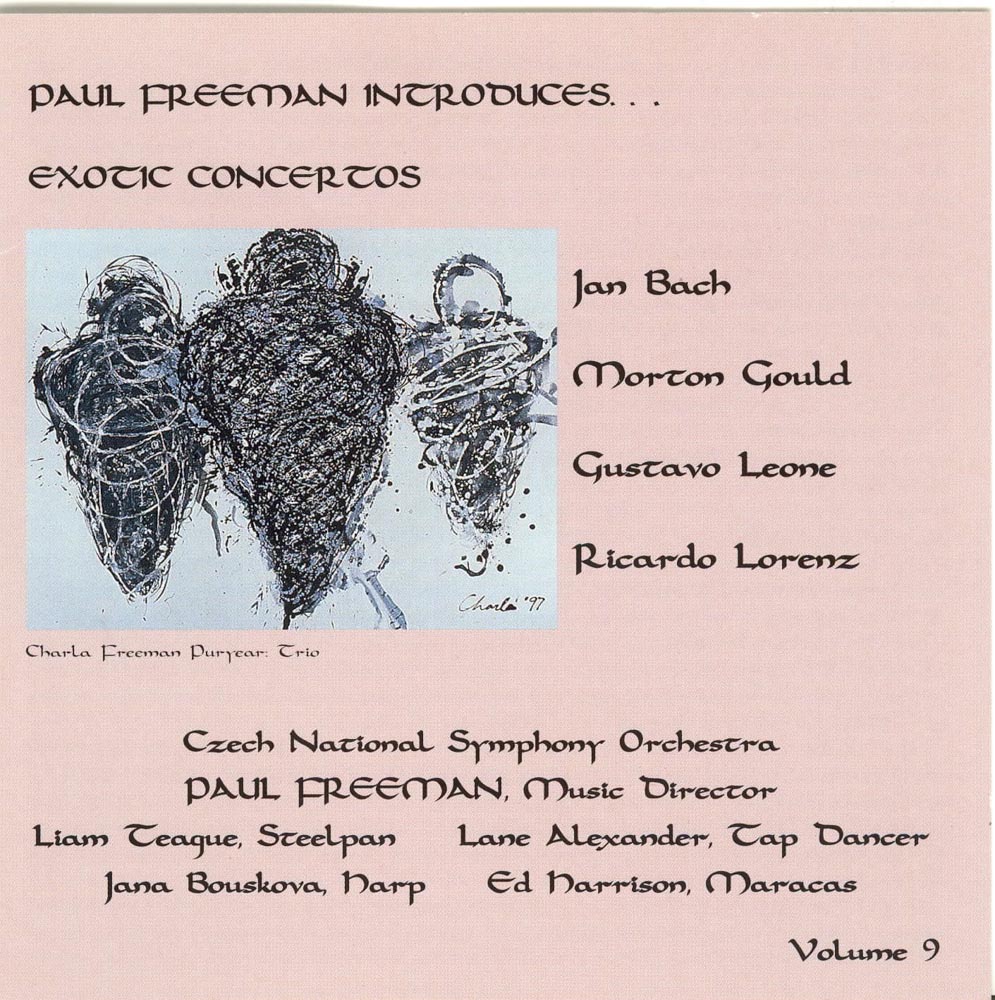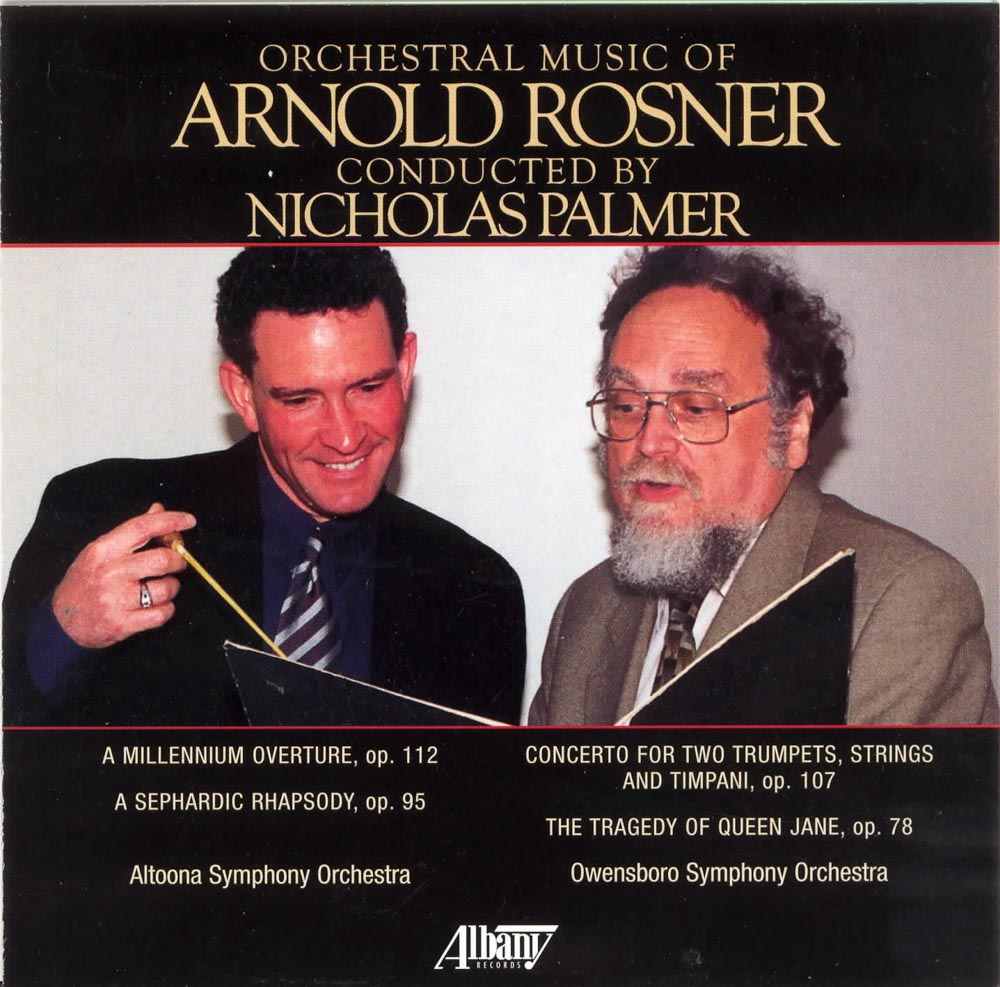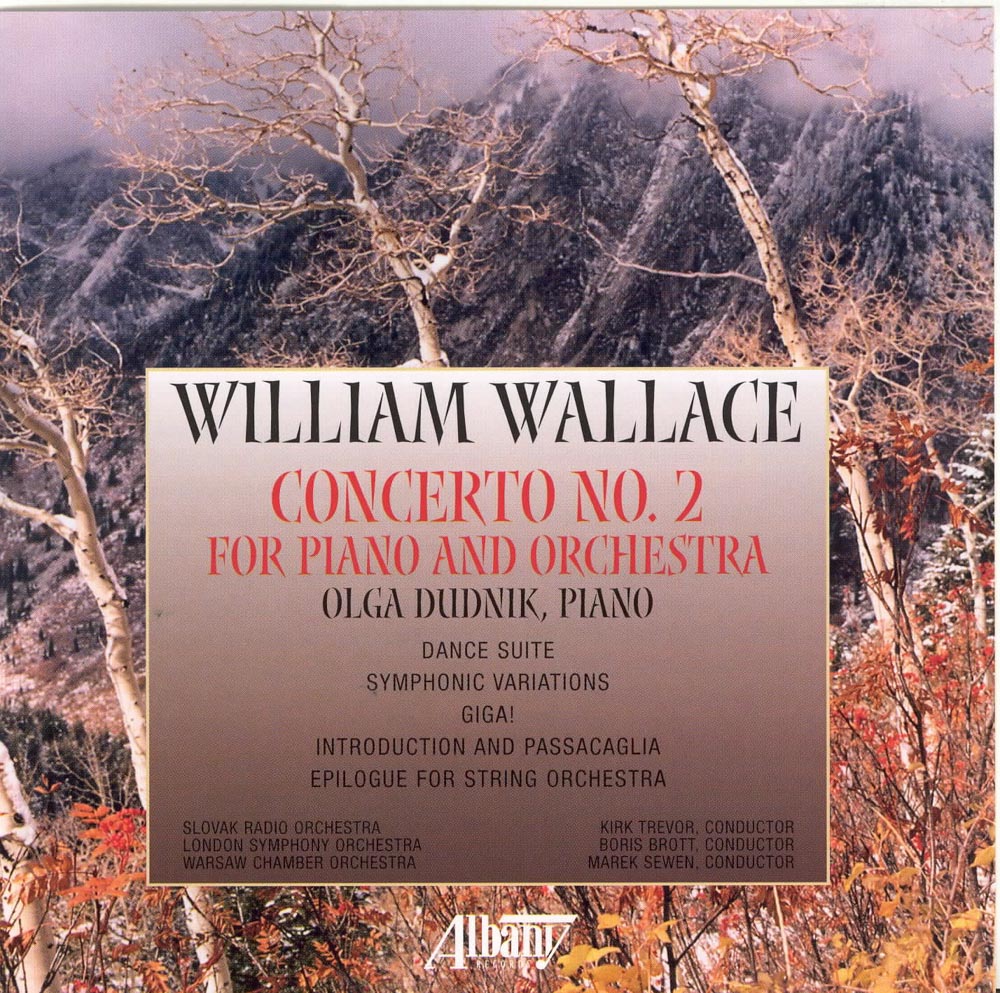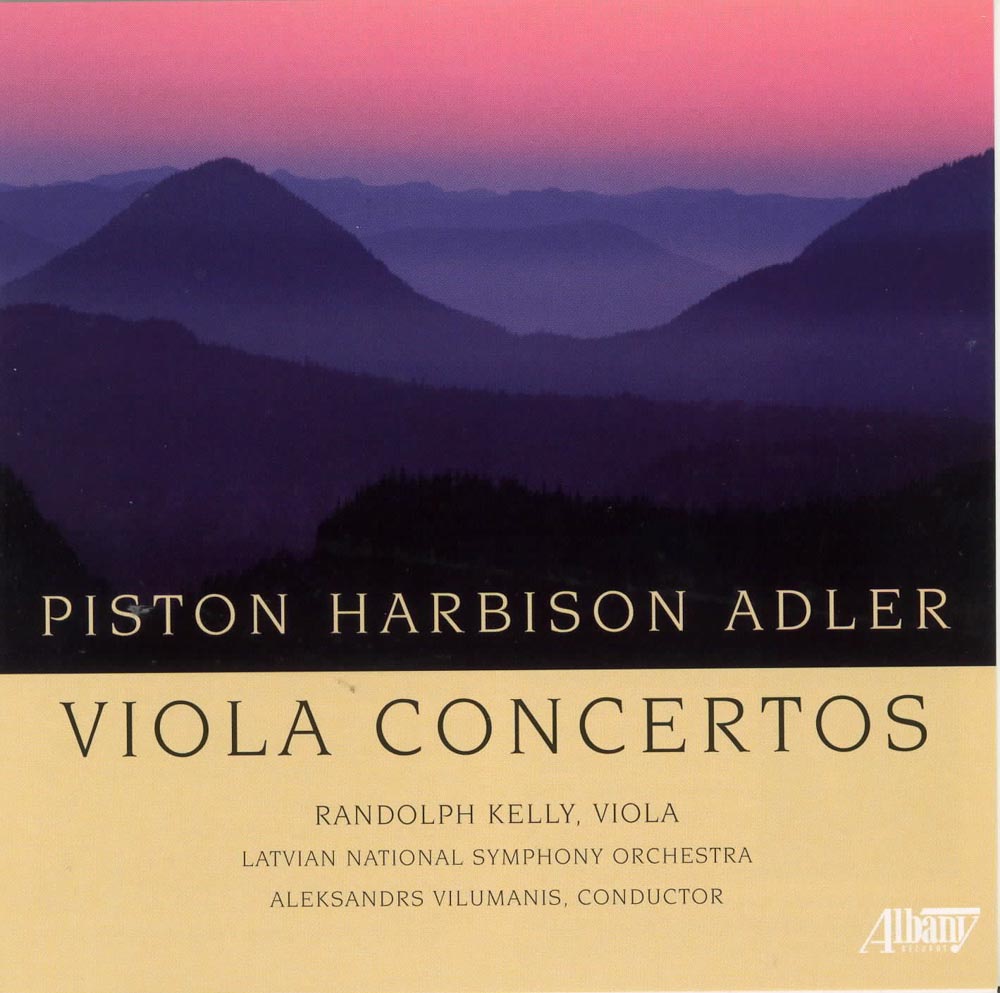Catalog #: TROY0400
Release Date: August 1, 2000OrchestralThis release fills a hole in the catalog large enough to drive a truck through. This is the world premiere stereo release, the world premiere CD release of Walter Piston's Third Symphony. The only recording of this serious, somber, most beautiful of Mr. Piston's symphonies was made almost fifty years ago by Howard Hanson for Mercury. The Symphony is dedicated to the memory of Natalie Koussevitsky. It is particularly appropriate for Jimmy Yannatos and the Harvard-Radcliffe Orchestra to bring us this important music because Piston was closely associated with Harvard throughout his life. He attended Harvard as an undergraduate, joined the faculty in 1926, and became a full professor in 1944, remaining at Harvard for many years. It is also just as fitting that this disc contains the work of another American composer closely associated with Harvard, James Yannatos, who has conducted the Harvard-Radcliffe Orchestra since 1964. Those who are familiar with Yannatos' other works on Albany Records will know what to expect from this fine composer. His Concerto for String Quartet and Orchestra was written for the Mendelssohn String Quartet while the composer was on a sabbatical leave from Harvard during February to June 1995. The Symphony No. 3 was commissioned by Joel Spiegelman in 1989 for concerts he was to conduct in the former Soviet Union with the Lithuanian State Symphony. Many customers will buy this CD because of the Piston Third, but they will be most pleasantly surprised at the bonuses presented to them by the music of Yannatos. His music is a perfect compliment to the music of Piston.
Catalog #: TROY0410
Release Date: February 1, 2001OrchestralP. Peter Sacco was born into an intensely musical family in Albion, N.Y. A long line of professional and amateur singers and instrumentalists provided a diverse and supportive context in which Sacco states: "I never thought of doing anything but music. I started at age four on the piano and haven't stopped since." He attended the Eastman Preparatory School of Music in Rochester where he studied theory, piano and voice. He was drafted during the Korean conflict and stationed in Frankfurt, Germany. There he studied at the Frankfurt School of Music. In 1953, he went back to Eastman, from which he graduated. From 1959 to 1981, he served on the faculty of San Francisco State University. Today he continues to teach, perform, and compose in Ashland, Oregon.
Catalog #: TROY0416
Release Date: October 24, 2000OrchestralThis collection of works by Respighi, Martinu and Musorgsky/Ravel is centered around pictures: Boticelli, Francesca, and Hartmann. Given stunning performances by the Long Beach Symphony conducted by Jo Ann Falletta, this is Albany's second release with this fine orchestra and world-class maestra.
Catalog #: TROY0425
Release Date: December 1, 2000OrchestralHere is one of Maestro Eshpai's greatest scores. This music was once available as a 2-LP Melodiya set and was long sought after by collectors. The sound has been re-mastered and is here presented on CD for the first time. In essence "A Circle" is a ballet symphony. So significant is the theme of the ballet, the landscape of the infinitely changing world, that one is naturally led to the idea of its treatment by purely orchestral, symphonic means outside any imagery. Lyricism occupies a prominent place in the ballet as does music from previous ages. There is the Viennese waltz, the military march, a gracious old-fashioned arrangement of the minuet. Of course rhythms of the 20th century permeate the work as do echoes of music from jazz bands and even a hint of rock. There are the sounds of bells throughout the work symbolizing death and there are lovely, lyrical themes from the strings symbolizing the two lovers. Here is music in the mainstream of Russian ballet. If you enjoy Shostakovich, you will love this new composition by Eshpai.
Catalog #: TROY0429
Release Date: January 1, 2001OrchestralHere is a great new disc featuring the wonderful music of an American composer performed by a fine American orchestra. What does Dankner's music sound like? Dankner of course, but also a slightly more modern (and inventive) Howard Hanson. As you will hear for yourself Dankner is a composer whose works encompass the breadth of scope and range of expression of the late-Romantic tradition. In his music, there is an emphasis on melody, rich textures, chromatic harmony and contrapuntal devices. The Louisiana Philharmonic is the only musician-owned and managed orchestra in the United States. It has a long-standing relationship with the composer Stephen Dankner, thus it is fitting that the orchestra's very first recording feature the music of Mr. Dankner. Each of the three works which appear on this CD were given their New Orleans premiere by the Louisiana Philharmonic and Hurricane and Song of Solomon were world premieres given by the orchestra. Dankner's music has earned applause, not only from the orchestra and its conductor, but also from audiences. Unlike the music of those composers Ned Rorem dubbed the "serial killers," his work is progressive but accessible, capturing a style of late-Romanticism while incorporating newer influences and voices. Listen for the rich, Straussian-like colors in the vivid "Hurricane." The sweeping expanse of love in all its delight and mystery infuses "Song of Solomon." And with the newest piece on the disc, the Concerto for Alto Saxophone, Dankner expands our perceptions of where this instrument fits in the world of classical music.
Catalog #: TROY0430
Release Date: June 1, 2001OrchestralRobert Xavier Rodriguez is one of the most significant and often-performed American composers of his generation. His teachers have included Nadia Boulanger, Jacob Druckman, Bruno Maderna and Elliott Carter. His Forbidden Fire, Cantata for the Next Millennium is scored for bass-baritone, double chorus and orchestra. The work was commissioned by the University of Miami School of Music and received its world premiere on October 17, 1998. Conceived as a companion piece to Beethoven's Symphony No. 9, it is a 22 minute exploration of dangerous or forbidden knowledge, as represented by the Promethean metaphor of stealing fire from the gods. Con Flor y Canto is a narrative cantata, the central portion of Rodriguez' Adoracion Ambulante (1994), a full-evening multi-media Mexican folk celebration. This work had its premiere in October, 1994. Scrooge, Concert Scenes from "A Christmas Carol" for bass-baritone, Chorus and Orchestra telescopes the actions and myriad characters of Dicken's story into an 18 minute tour de force of five short scenes featuring the single character of Scrooge accompanied by a chorus of ghosts and holiday revelers.
Catalog #: TROY0431
Release Date: January 1, 2001OrchestralThe works on this CD represent the rich, imaginative and varied scope of contemporary Black artists' landscapes and musical horizons. The composers, who represent various voices in style, generation and compositional approaches contained within the African American artistic experience, handle the cultural materials in ways that are not only cohesive but eloquent. These efforts further illuminate the attempt of contemporary artists to broaden, stretch, and expand the languages and forms of the modern orchestral culture. This partially live recording of the Prague Radio Symphony and Washington Symphony Orchestra, captures the essence of African American contemporary sacred and secular life through music. This recording does a great service to what composer T.J. Anderson calls, "the duty of the composer to document the culture." David Baker's Shades of Blue was commissioned by and written for the Roanoke Symphony, which premiered it in 1993 under Victoria Bond. The commission specified an orchestral work with a strong jazz influence but not requiring outside soloists. Leslie Adams' Ode to Life was commissioned by the Cuyahoga Community College of Cleveland on the occasion of its 15th anniversary. The composer considers it a "celebration of life itself." Stephen Newby's Gospel Songs were composed for Willis Patterson. They are really a compilation of four gospel songs.
Catalog #: TROY0436
Release Date: March 1, 2001OrchestralBorn in LaGrange, Illinois, Scott Steidl grew up in Minneapolis. There he studied piano, bassoon, and saxophone and developed an interest in playing jazz. Later as an undergraduate at Brown University, he studied composition with Ron Nelson and continued his activities in the field of jazz as director of the Brown University Stage Band. After graduating from Brown, Steidl studied composition with David Diamond and Elliott Carter at the Juilliard School, earning his Masters and Doctoral degrees in composition. He then completed his education by pursuing his other major interest: medicine. He also holds a doctoral degree in medicine from the Mount Sinai School of Medicine and specialty training at Harvard Medical School. His music is rooted in the vernacular of our time and represents the varied influences and rich imagination of the current American culture. His work strikes a balance among contrasting influences. A lover of popular music, jazz, music theater and western classical music, his musical point of view is inclusive rather than exclusive. In a concise description of Scott Steidl's music in The New York Times, John Rockwell characterized his work as "All-American."
Catalog #: TROY0441
Release Date: May 1, 2001OrchestralYou are saying to yourself: Self! Why a disc with two short orchestral pieces and two major new piano concertos? The answer is simple. Each concerto is preceded by a short overture - a curtain raiser, if you will, to prepare the listener for what is to come. Andrew Bishop is a young American composer who studied in Michigan with William Albright, William Bolcom and Michael Daugherty. He is also an active saxophonist who has worked with Ray Charles, The Manhattan Transfer, and the Nelson Riddle Orchestra. "Crooning is a love song without words. Its inspiration is the Golden Age of American popular songs brought to life by Ella Fitzgerald, Sarah Vaughan, Billie Holiday and Frank Sinatra." Allen Shawn studied music with Leon Kirchner and Earl Kim at Harvard, in Paris with Nadia Boulanger and at Columbia with Jack Beeson. Since 1985 he has been on the faculty of Bennington College where he teaches composition. He wrote his Piano Concerto for Ursula Oppens who premiered it with the Albany Symphony on March 18, 2000 in the Troy Savings Bank Music Hall. The great American composer Benjamin Lees wrote his Piano Concerto No. 2 for the Boston Symphony Orchestra who premiered it in Boston on March 15, 1968. It is great to see more and more of Lees' music showing up on disc. About the delightful Paul Creston Dance Overture, suffice it to say that here this infectious piece finally receives a performance that is worthy of its title.
Catalog #: TROY0467
Release Date: October 1, 2001OrchestralThe reasonably experienced listener encountering the music of Louis Gruenberg for the first time is likely at various moments to receive a general impression of artistic kinship with such composers as Szymanowski and Messiaen. Those with a more specialized knowledge of 20th century music may hear a certain affinity with another long neglected creative figure, Igor Markevitch. Better known as a conductor, Markevitch (1912-1983) was widely regarded in the 1930s, by no lesser judges than Bartok and Milhaud, as the outstanding composer of his generation. Markevitch was once described as a "dry mystic", a phrase that might also be used to describe Gruenberg's music. Brought to the United States when he was two, Gruenberg was essentially an American phenomenon. He did do some studying (with Busoni and Koch) and then some teaching and piano-playing in Europe between 1903 and 1919, and one of his most successful dramatic works, The Emperor Jones, premiered at the Metropolitan Opera in 1933, was to achieve a revival in Rome in 1950. But most of his career was spent in the United States, where he was one of the founders of the League of Composers in 1923 and headed the composition department at Chicago Musical College from 1933 to 1936, afterwards moving to California. More pertinently, he devoted much attention to American musical genres, publishing four volumes of spiritual harmonizations, and deriving substantial inspiration from jazz for The Daniel Jazz and several other works. The three works recorded here show relatively little trace of these American resources, fitting for the most part into a broadly European musical tradition that he shared with many compatriots of his generation.
Catalog #: TROY0474
Release Date: March 1, 2002OrchestralDaring and energy are the two basic elements with which Leonardo Balada approaches his very personal compositions. This total musician has blended his strong vocation with his teaching since 1970 at Carnegie Mellon University in Pittsburgh, where he is University Professor of Composition. He started his piano and theory studies in his native Barcelona, finishing in 1953. Then he studied composition at the New York College of Music and the Juilliard School. The fact that he finished his studies in 1960 could suggest that he was part of the so-called "generation of '51" of Spanish composers. Because of geographical distance he did not participate in the early activities of that group, which was so important to the Spanish music of the sixties. This does not mean he did not identify with them esthetically and ideologically. At the beginning, his compositional direction did not conform to that of his contemporaries, who generally followed the paths of Paris or Darmstadt. The almost obligatory twelve-tone style was not attractive to him. Having left the European continent allowed him the possibility of approaching other musical languages. This he did as one will hear in the broad selection of his orchestral music presented on this disc.
Catalog #: TROY0477
Release Date: February 1, 2002OrchestralCurrently one of America's finest composers (and one of the most popular in the Albany Records catalog), Eric Ewazen is on the faculty of Juilliard. About the music on this CD, Ewazen writes: "In 1992, James Houlik came over to my Manhattan apartment to show me what he could do on the tenor saxophone. His spectacular playing caused unbelievable comment from my neighbors and I was hooked on his beautiful, intense tone. His abilities at playing the most exciting and virtuosic repertoire and his total command of all ranges and means of expression inspired me to write a work showcasing his amazing talents. My Ballade was composed for my friend Jean Kopperud in 1986, who presented the work at Merkin Hall in New York City. It was written while I was guest composer at the Tidewater Music Festival in Southern Maryland. Outside my guest cottage was the beautiful Chesapeake Bay. In the balmy summer weather, with the water gently lapping the shore, I wanted to describe this unbelievably pastoral scene with music. This was the birth of the Ballade. My Flute Concerto was written in 1988 for Julius Baker, the legendary flute player of the New York Philharmonic. He premiered the work in 1989 in Merkin Hall in New York City. My Chamber Symphony was composed in 1985 for the Fairfield Chamber Orchestra, conducted by Thomas Crawford, who commissioned the work. The wonderful pianist Margaret Mills, first played the prominent piano part (played by the composer on this CD). The piano takes the role of the harpsichord in Baroque orchestral music."
Catalog #: TROY0481
Release Date: November 1, 2001OrchestralStanislaw Skrowaczewski retains a unique position on the international musical scene, where he is both a renowned conductor and a highly regarded composer, especially of large scale orchestral works. Born in Lwow, Poland but resident in the U.S. since 1960, Skrowaczewski showed great promise as a pianist, making his debut with the Beethoven Triple Concerto, but an injury to his hands during World War II terminated his keyboard aspirations. Composing and conducting became his double focus. Directly after the War - still in his mid-twenties - he was named music director of the Breslau Philharmonic, then the Katowice Philharmonic, Krakow Philharmonic and then the Warsaw National Orchestra. During this period he also studied with Nadia Boulanger in Paris. In 1958, at the invitation of George Szell, he made his American conducting debut with the Cleveland Orchestra. In 1960, he was named music director of what was to become the Minnesota Orchestra, a position he was to hold for 19 years. His Passacaglia Immaginaria was completed in 1995. It unfolds in a provocative sound world. Similar to the Passacaglia of the Baroque era, a species of continuous variations on a ground, his design is based on the principle of metamorphosis. The work was commissioned by the Minnesota Orchestral Association and Eiji Oue gave the premiere with the Orchestra on April 10, 12 and 13,1996. For its 35th anniversary season in 1993-94, the St. Paul Chamber Orchestra, requested a new work from Skrowaczewski. The resulting Chamber Concerto was premiered on November 26, 27, 1993. In January 1981, while guest conducting in Frankfurt, Germany, Skrowaczewski finished his Clarinet Concerto, which he dedicated to Joseph Longo, the co-principal clarinetist of the Minnesota Orchestra. The premiere of this work was April 15,17,18, 1981 and again the composer conducted the orchestra.
Catalog #: TROY0486
Release Date: March 1, 2002OrchestralComposer and conductor, Anthony Iannaccone, is one of a handful of contemporary artists whose exploration of musical polarities in the 1960's and 70's consistently separated their output into populist and specialist works. In the world of music, the former tended to be tonal and accessible, while the latter leaned toward atonality and abstraction. In his own case, Iannaccone refers to these categories as "large-audience" and "small audience" music, respectively. The first three pieces on this disc demonstrate a remarkable blending and balancing of both "small" and "large-audience" music. The last two works clearly inhabit the realm of the "large-audience." Not unlike the overview afforded on earlier Albany releases of Iannaccone's music for strings (TROY 414) and music for winds (TROY 280), this CD includes works that span nearly two decades of music for the orchestral medium. From his earliest orchestral venture, Suite for Orchestra, to his most recent, From Time to Time, one can trace the development of a truly personal voice from an early mixture of influences, both traditional (Brahms, Debussy, Mahler) and modern (Stravinsky, Berg, Copland, Bartok).
Catalog #: TROY0490
Release Date: April 1, 2002OrchestralDavid Heuser's degrees are from Eastman and Indiana University and his composition teachers have included Samuel Adler, Joseph Schwantner and Warren Benson. A native of New Jersey, Mr. Heuser currently resides in San Antonio, where he is a faculty member at the University of Texas at San Antonio. Cauldron was commissioned and premiered by the New York Youth Symphony. Donald Crockett was born in Pasadena, California. He is Professor of Composition and Director of the Contemporary Music Ensemble at the University of Southern California Thornton School of Music where he joined the faculty in 1981. From 1991-1997 he was composer-in-residence with the Los Angeles Chamber Orchestra. Roethke Preludes was commissioned by the Los Angeles Chamber Orchestra and given its premiere performances in February 1995. It comprises six short movements, with the entire piece taking a little over a quarter of an hour. Pulitzer Prize and Grammy award-winning composer Stephen Albert, whose tragic death in 1992 stunned the music world, was recognized in his lifetime for a body of work at once powerful, dramatic, colorful and deeply emotive. He won the 1985 Pulitzer Prize for his symphony River Run and from 1985 to 1988 served as composer-in-residence with the Seattle Symphony. Albert's gift for writing vocal music is also reflected in his last concerto, the sweetly lyrical Wind Canticle for clarinet and orchestra, tailor-made for soloist David Shifrin and the Philadelphia Orchestra. Bernard Rands is considered one of the world's most renowned composers. He has been acclaimed as a major figure in contemporary music with more than 90 works for a wide range of genres, including large choral and symphonic compositions, chamber music and music theater pieces. ...body and shadow... was composed in 1988 in response to a commission from the Boston Symphony Orchestra and was first performed by that orchestra in 1989 under Seiji Ozawa. It is, in effect, a concerto for orchestra in that over the course of the work's two movements, each section of the orchestra is featured.
Catalog #: TROY0491
Release Date: June 1, 2002OrchestralBrian Fennelly is Professor Emeritus in the Faculty of Arts and Science at New York University, where he taught from 1968 to 1997. Following a degree in engineering from Union College, he studied music at Yale with Mel Powell, Donald Martino, Gunther Schuller and George Perle. The five works recorded on this CD cover a 21 year period in the creative life of the composer. Among the consistent, remarkable features of Fennelly's orchestral works from these years - the elements which define his distinctive compositional voice are the abundant paradoxical tendencies: steadfast resistance to fashion, coupled with frequent signs of his awareness of contemporary compositional trends; nearly obsessive dedication to formal transparency, coupled sometimes with impressionistic, sensuous orchestral textures and the masking of structural divisions; strong goal orientation through progressions of phrases leading to powerful climaxes, coupled often with rhapsodic passages of a seemingly static nature; pitch organization clearly derived from dodecaphonic or hexachordal procedures, coupled frequently with motives and harmonies selected for their apparent non-serial associations (suggestive of, but not operating functionally in, traditional tonality or modality). This album reveals Brian Fennelly as a craftsman of sober, weighty music built to stand objectively, i.e. by the strength of its own content and architecture.
Catalog #: TROY0497
Release Date: December 1, 2001OrchestralHarold Farberman writes: "Unlike Volume One (Albany TROY402) which was entirely devoted to early chamber music, Volume Two contains music for orchestra. The musical agenda is different for each work: a film score, a song cycle, a short elegy for strings, a fable for children and a symphony for percussion and strings. Atonality and tonality, including a nod to the American "pop" culture of the 50s, are employed in contrasting structures and differing styles. Incisive rhythms and a full color palette remain a constant. The film, The Great American Cowboy won the Academy Award in 1973 for the best documentary. The film contained over sixty minutes of music for symphony orchestra. War Cry was a bicentennial commission from the Colorado Springs Symphony . It was premiered on November 11, 1976 by the orchestra. Elegy for String Orchestra was written in memory of my brother Leo and is dedicated to his memory. I conducted the premiere in Carnegie Hall on March 14, 1965. Tree Branch was premiered on March 7, 1998 by the Garden State Philharmonic. For a long time my colleagues have complained about the paucity of original works for children's concerts that include the conductor as the central figure. I searched for but could not find a suitable text until I looked at a branch of a tree and envisioned a baton. The rest, including the text, was easy. The intent of my Symphony was to unite the special sound qualities of a large percussion section with strings, and to acknowledge the role of percussion in our "pop" culture. The Symphony might be labeled a "cross-over" work and perhaps it is. Louie Bellson, Tito Puente, Jascha Heifetz and the Budapest Quartet shared my record shelf. However, the term "cross-over" was not yet in our vocabulary in 1957."
Catalog #: TROY0499
Release Date: May 1, 2002OrchestralAdolphus Hailstork composed his Sonata da Chiesa (church sonata) on commission from the Thomas Jefferson High School for Science and Technology in Alexandria, Virginia for its string orchestra. It was premiered there in 1992. The Sonata da Chiesa reflects the composer's fascination with cathedrals, particularly the Cathedral of All Saints in Albany, N.Y. where he was a chorister as a child. Today, Adolphus Hailstork is a professor at Norfolk State University in Virginia. Jiri Gemrot was born in Prague into a family of musicians. His work, American Overture, was written for Paul Freeman and the CNSO and was premiered in Prague in 1996. Gemrot's language utilizes 20th century elements, though it is his aim to fuse styles uniting past and present. His music might best be described as being aligned with neoclassicism. Richard Felciano is a native of California and today teaches at the University of California, Berkeley where he is a Professor of Music. There, he is also the founder of the Center for New Music and Audio Technologies. The Symphony for String Orchestra was composed for the Orquestra Filamonica de la Cuidad de Mexico, which gave the premiere performance in February 1994. Mark D. Petering's Overture Celebration is taken from a larger work (the finale of his First Symphony). The composer uses the tone palette of the orchestra as an artist would in making bold splashes of color in a painting. The work was commissioned by the PieperPower Foundation. David Nathaniel Baker, Jr. is a native of Indianapolis and currently holds the position of Distinguished Professor of Music and Chairman of the Jazz Department at Indiana University. "Images of Childhood is one of only a handful of compositions I have written in the last 20 years which was not written on commission. I thought it would be fun to write a piece about my memories of growing up in the Indianapolis of the late 1930s and early 1940s, and Images of Childhood was the result."
Catalog #: TROY0502
Release Date: June 1, 2002OrchestralAn American born B.C. - which in the present context means "before Copland" - had a hard time of it if he wanted to become a composer. The job, rather like that of an actress in the 18th century, was not considered quite proper for a gentleman. By virtue alike of his talent and international recognition, of his character, and of his dedication to the support and encouragement of his colleagues, Aaron Copland changed all that in the public mind, and already by the time Elie Siegmeister, Norman Dello Joio, and Jacob Avshalomov came on the scene, composing was beginning to be seen as a perfectly feasible and respectable, if not necessarily lucrative, profession. Thus it was that even a musician who came to be as widely admired as Converse, after graduating in 1893 from Harvard College with high honors in music, tried for some months to be a businessman, in accordance with his father's wishes, before an irresistible inner need compelled him to turn to music; and Tuthill pursued a similar course for much longer, despite having a father, William B. Tuthill, who was the architect of Carnegie Hall, and a mother, Henrietta Corwin Tuthill, who was a professional organist. It is a real treat to have the fine American conductor, JoAnn Falletta conducting the equally fine American clarinetist Robert Alemany and the Czech National Symphony in these wonderful performances.
Catalog #: TROY0507
Release Date: May 1, 2002OrchestralThe composer, conductor and pianist Jeff Manookian is the music director and conductor of the Intermountain Classical Orchestra and the University of Utah SummerArts Orchestra. His Concerto for Flute and Orchestra was a commission from the Barlow Endowment for Music Composition. It is luxuriantly post-romantic in its tonal casting. The concerto received its premiere on September 26, 2001, in Yerevan, Armenia with the same forces as appear on this recording. The United States premiere took place a week later in Salt Lake City, Utah on October 5, 2001, with James Michael Caswell conducting the Salt Lake Symphony Orchestra. On April 24, 1915, the Ottoman Turks rounded up and killed the Armenian leaders, writers, thinkers and professionals in Constantinople (present day Istanbul). From 1915-1923, the Ottoman Turk empire carried out an epic genocidal campaign where more than half of the Armenian population, throughout Anatolia, was brutally murdered. Symphony of Tears carries the listener through the tragic events and deeply felt emotions of the Armenian genocide. This work endeavors to honor the dead of this horrific event, comfort its survivors, educate the public about this tragedy, promote hope for the future of all peoples and console those who have suffered or are the progeny of the crimes of hate. The Symphony of Tears was premiered on April 30, 2000 at the Cathedral of the Madeleine in Salt Lake City, Utah by the Oratorio Society of Utah and the Madeleine Festival Orchestra, Joel Rosenberg conducting.
Catalog #: TROY0508
Release Date: June 1, 2002OrchestralIrwin Bazelon completed Symphony No. One in February, 1961 at the age of 38. A vigorous 30 minute statement full of vitality, swagger and confidence, the fingerprints of his future symphonies and a recognizable compositional sound are already evident. The composer abandoned the traditional four movement classical structure and in another bold stroke he reshaped and used standard jazz elements as his basic material. If American style jazz is the true American music, as is most commonly believed today, it is hardly a stretch to think of Bazelon's orchestral sounds as derived from American roots. Orchestrated for wind quintet and harpsichord, the Early American Suite is based on a score Bazelon wrote in the summer of 1965 for legendary documentary director Willard van Dyke. The concert version was completed in November-December the same year. The eight short movements of this charming suite reveal Bazelon as adept in miniature structures as he is formidable in his long-form symphonic works. The Suite from Shakespeare's "The Merry Wives of Windsor" was drawn from original theater music composed for John Houseman's American Shakespeare Festival Theater in Stratford, Connecticut in 1959. Though completed in January of 1960, this recording is the first concert performance of the music.
Catalog #: TROY0509
Release Date: May 1, 2002OrchestralThe Miramar Sinfonietta was founded in the spring of 2000 specifically to record the Fantasy on Two Christmas Carols in honor of what would have been the composer's 100th birthday. The group was later reassembled for the purpose of recording works by outstanding composers, mostly Americans, that have not been recorded as yet, and deserve to be heard. The chamber orchestra consists of some of the finest musicians in the Milwaukee area, all of them engaged in various professional organizations in that area. Jeani Foster is the principal flute of the Milwaukee Symphony Orchestra. William Barnewitz serves as principal horn of the Milwaukee Symphony and the Sante Fe Opera Orchestra. Samantha George is the associate concertmaster of the Milwaukee Symphony and has also been a member of the Colorado and Hartford Symphony Orchestras. Eric Segnitz is a founding member and solo violinist of the highly regarded contemporary music group, Present Music. Henri B. Pensis, founder and conductor of the Miramar Sinfonietta, was active as professor of music and conductor for a period of 30 years at the University of Wisconsin Oshkosh.
Catalog #: TROY0514
Release Date: May 1, 2002OrchestralIn recent years the music of Roberto Sierra has received much attention and has met with particular acclaim both in North America and Europe. He was born in Puerto Rico where he pursued early studies at the Conservatory of Music and the University of Puerto Rico. After graduation, he went to Europe to further his musical knowledge, studying first at the Royal College of Music and the University of London, and later at the Institute for Sonology in Utrecht. Between 1979 and 1982, he did advanced work in Hamburg with Gyorgy Ligeti. In 1982, Sierra returned to Puerto Rico to occupy administrative posts in arts administration and higher education, first as Director of the Cultural Activities Department at the University of Puerto Rico, and later as Chancellor of the Puerto Rico Conservatory of Music. In 1989 Roberto Sierra became Composer-in-Residence of the Milwaukee Symphony Orchestra. In addition to advising the MSO on American repertoire, he contributed to the musical life of Milwaukee with a number of new works, including pieces for local chamber and choral ensembles, and for individual musicians. He is currently teaching composition at Cornell University. During the 2000-2001 season Sierra was Composer-in-Residence with the Philadelphia Orchestra.
Catalog #: TROY0515
Release Date: August 1, 2002OrchestralWith this release, the Albany Symphony Orchestra brings to light two major American symphonies that have been unjustly neglected for more than half a century. These works were conceived with great optimism and enthusiasm by their creators, young men then ascending the crest of celebrity and now ranked among America's most important 20th century composers. But both symphonies had difficult entrances into the world, their original spark dimmed by patchings and pasteups imposed to correct supposed musical shortcomings. In spite of the revisions both men acquiesced to, however, critical reaction to the symphonies was disappointingly mixed. Harris withdrew his piece. Gould's soon faded from the repertoire. This was the situation when the Albany Symphony Orchestra pursued programming both of these works. Having already recorded music by Gould and Harris, the orchestra had faith in the validity of the composers' initial creative impulses. A score and set of instrumental parts to the unknown original version of Gould's Third were tracked down. These were used for this recording. Then, Ray Bono, the Albany Symphony Orchestra's copyist, worked to restore the bulk of the original material Harris had expunged from his Second Symphony. Also, the errors in the almost 75 year old score and parts had to be corrected. It is this version of the symphony that is heard on this recording - the original version. The result? A pair of performances that masterfully recapture the original intent of two gifted creators approaching the peak of their form. They music they offer us is powerful, confident and dramatic. Sometimes quirky, always compelling, it is also unmistakably American. As such, it stands in openhearted contrast to the icily cerebral complexities resonating in Europe just before and after the devastation of World War II.
Catalog #: TROY0516
Release Date: August 1, 2002OrchestralAbout his Symphony No. 5 James Yannatos writes: "Symphony No. 5: Sons et Lumiere (1991) derives its title from the sound and light shows so popular in France in which historical events related to a particular epoch, chateau, or monument are dramatized through the use of sound and light. The title alludes to past as well as to present events in which the political face of Europe and Africa is changing. On another level, Sons et Lumiere refers to vibrations and waves that move through real time and space in the form of sound and interplay between the various levels of musical sound and meaning, referring to our physical world as we live it, our sensory world as we see, hear and feel it, and our spiritual world as we attempt to comprehend it." In May of every other year more than 900 cello lovers - from beginning cellists to esteemed cello soloists - congregate in Manchester, England for the International Cello Festival. The brain-child of cellist Ralph Kirschbaum, this festival features workshops, films, exhibitions, and performances by and for cellists. The Festival almost always features a premiere of a cello piece, and in 1994, Yehudi Wyner was commissioned to compose a piece for cello and orchestra. The result was the Prologue and Narrative for cello and orchestra, which Wyner himself describes: "Finding a title for the piece has been a difficult task. To call it a Concerto for Cello and Orchestra would be misleading, since the term "concerto" implies a form as well as a relationship. In general, my musical thinking is not comfortable with conventional modes of construction, nor does it rely on received conventions of form. While the music is constructed with great attention to contextual unity and formal coherence, it also strives for a sense of the informal, the improvisational, the spontaneous." Composer Charles Fussell was Artistic Director of New Music Harvest, Boston's first city-wide festival of contemporary music and Co-Founder and Director of the New England Composer's Orchestra. He is a member of the composition faculty at Boston University. His Symphony No. 5 was written in 1994-95 in memory of Virgil Thomson. The premiere was given November 1996 by the New Hampshire Symphony under the direction of James Bolle.
Catalog #: TROY0517
Release Date: July 1, 2002OrchestralDan Locklair, a native of Charlotte, North Carolina, holds a Master of Sacred Music degree from the School of Sacred Music of Union Theological Seminary in New York City and a Doctor of Musical Arts degree from the Eastman School of Music. Presently, he is Composer-in-Residence and Professor of Music at Wake Forest University in Winston-Salem, North Carolina. In its centennial year, Dr. Locklair was named 1996 AGO Composer of the Year by the American Guild of Organists, a distinguished honor awarded yearly to an American composer who has not only enriched the organ repertoire, but who has also made significant contributions to symphonic and concert music. His 1995 composition, Since Dawn (A Tone Poem for Narrator, Chorus and Orchestra based on Maya Angelou's On the Pulse of Morning), is the first musical setting of Maya Angelou's well-known and important poem commissioned for the 1993 Inauguration of President Clinton.
Catalog #: TROY0519
Release Date: July 1, 2002OrchestralRonald Perera is the Elsie Irwin Sweeney Professor of Music at Smith College. His compositions include operas, song cycles, chamber, choral and orchestral music and several works that combine instruments or voices with electronic sounds. Donald Wheelock is Irwin and Pauline Alper Glass Professor of Music at Smith College, where he has been a member of the faculty since 1974. His teachers include Edgar Curtis, Kenneth Leighton, Quincy Porter and Yehudi Wyner. His works include four string quartets, two symphonies, many works for solo instruments, eleven song cycles and many larger ensemble and orchestral works. Ed London is known primarily as a composer and conductor. His teachers included Gunther Schuller, Luigi Dallapiccola and Darius Milhaud. Like two other composers and one of the performers on this recording, he has a connection with Smith College, having taught there for most of the 60s. Since then he has taught at the University of Illinois and at Cleveland State University, where he founded the Cleveland Chamber Symphony, the award-winning ensemble renowned for its enthusiastic performances of the works of living composers. The name Otto Luening appears most frequently in conjunction with his pioneering efforts with Vladimir Ussachevsky in the early days of electronic music. His talents, however, ranged far wider than experimentation in this area. He was trained extensively, both in Europe and America, as a flautist, conductor and composer, and his career, both as flautist and conductor, was considerable.
Catalog #: TROY0521
Release Date: September 1, 2002OrchestralThis recording brings together some wonderful concertos for orchestra and unusual instruments, most of which are first recordings. The solo part of Jan Bach's Steelpan Concerto was actually written for soprano pan, a steel instrument that usually plays the primary part in the Caribbean steel bands. The work was composed in 1994 for Liam Teague, a young musician from Trinidad whose musicianship inspired the work. Morton Gould's Concerto for Tap Dancer and Orchestra, written in 1952, brings together Gould's flare for Americana and his passion for dance. Inspired by the percussive quality of the tap medium, Gould's concerto is typically inventive in mixing musical tradition with modern American culture. Leone's Harp Concerto was commissioned and premiered in 1994 by Concertante di Chicago with Elizabeth Cifani as soloist. Like all his music, it is influenced by the popular music of Latin America where he grew up. Ricardo Lorenz was born in Maracaibo, Venezuela in 1961 and is considered one of the most prominent Venezuelan composers of his generation. Playing the maracas in Venezuela has developed into a highly virtuosic art form that is considered by connoisseurs as one of the world's most sophisticated vernacular percussion techniques. One of these connoisseurs is Chicago's Lyric Opera percussionist Ed Harrison, for whom the concerto was composed. Harrison learned to play the maracas in the typical Venezuelan style during his tenure as percussionist of the Orquesta Filarmonica de Caracas.
Catalog #: TROY0543
Release Date: November 1, 2002OrchestralShirl Jae Atwell earned a bachelor of music education degree from Kansas State Teachers College and master of music theory/composition degree at the University of Louisville and completed four years of post-graduate work in composition at the University of South Carolina. An active composer, she still finds time to serve as a full-time string orchestra educator with the Jefferson County Public Schools, Louisville, Kentucky. She is currently serving as President of the Kentucky Cello Club. Her ballet, Lucy, with music by Ms. Atwell and choreography by Alun Jones, was premiered by the Louisville Ballet in January 1999. The ballet was inspired by the discovery of the 3.2 million year old skeleton in 1974. The ballet was the subject of a Kentucky Education Television documentary that was aired on November 10, 1999. In June 2000, the televised production of Lucy was awarded the Arts & Culture Emmy by the Ohio Valley Chapter of the National Academy of Television Arts & Sciences.
Catalog #: TROY0548
Release Date: November 1, 2002OrchestralArnold Rosner is a prolific American composer whose music has been performed in the United States and Israel. His works exceed 100 in number and steer clear, generally, of both the post-serial avant-garde movement of the 1960's and the minimalist movement which followed it. His treatment of harmony and counterpoint, along with the occasional recourse to an ethnic, Middle Eastern flavor, places his music in the esthetic milieu of Paul Hindemith, Ernest Bloch, and Alan Hovhaness. Rosner is currently on the faculty of Kingsborough Community College of the City University of New York, where he teaches both standard and ethnic music. Having composed since the age of nine, he received advanced degrees from the State University of New York at Buffalo while studying with Leo Smit, Allen Sapp, Henri Pousseur and Lejaren Hiller, from all of whom, in his own words, "I learned practically nothing."
Catalog #: TROY0557
Release Date: March 1, 2003OrchestralNot to be confused with the Scottish composer William Wallace (1860-1940), this William Wallace is a man of our time. His works, widely performed and broadcast. He studied with Leroy Robertson at the University of Utah and Egon Wellesz and Edmund Rubbra at the University of Oxford. He has taught at both Rutgers University and Canada's McMaster University. He holds both U.S. and Canadian citizenship and lives in Jackson Hole, Wyoming.
Catalog #: TROY0558
Release Date: February 1, 2003OrchestralNicholas Slonimsky once wrote: "Walter Piston has reached the stardom of the first magnitude. He has not exploded into stellar prominence like a surprising nova, but took his place inconspicuously, without passing through the inevitable stage of musical exhibition or futuristic eccentricity." Here we have the first modern performance of his wonderful Viola Concerto to appear on CD. John Harbison writes about his Viola Concerto: "The viola was my instrument of choice, the one I picked out as a very young concert goer. It had a commanding awkward size, a somewhat veiled, slightly melancholic tone quality, and it seemed always in the middle of things, a good vantage point for a composer (which I already wanted to be). It was frustrating to put up with beginning on the violin and I was told I could switch when my hands got bigger. When it was clear I would never have large hands I insisted on switching anyway and my first summer as a violist was spent in an informal chamber music group playing Haydn Quartets. That summer in Princeton, New Jersey, I remember as my happiest, the company of my friend John Sessions in the quartet, the wonder of the music we were exploring and the possibilities of the instrument I had always wanted to play. When it came to writing a concerto for viola I wrote a piece for the violist I never was, the true soloist, and the instrumental timbres I felt to be most typical of the instrument, its tenor voice, rather than its rather unnatural treble." Sam Adler writes: "The Concerto for Viola and Orchestra was begun in December 1998 and completed in February 1999 on a commission from the Pittsburgh Symphony Orchestra for its principal violist Randolph Kelly. This is the tenth concerto I have composed. The viola has a very special significance in my life since it was my major performing instrument in both chamber music situations as well as in the orchestra. To me, the major attribute of the viola is its ability to convey a most beautiful lyricism." More information on Randolph Kelly can be found at his website: www.randolphkelly.com.
Catalog

©2024 Albany Records. All rights reserved. | Privacy Policy | Website by PARMA Creative.
